Stay tuned for 2025 details!
We’d love to continue sharing regionally adapted fruit and nut trees with you for years to come, Friends! Since Fruition has transformed from selling to sharing seeds as gifts, we’re still dreaming up what sharing trees will look like and thank you for your patience and grace. If you’re wondering how to stay in touch and be part of it all, join our email list and take a peek at our reciprocity invitation.
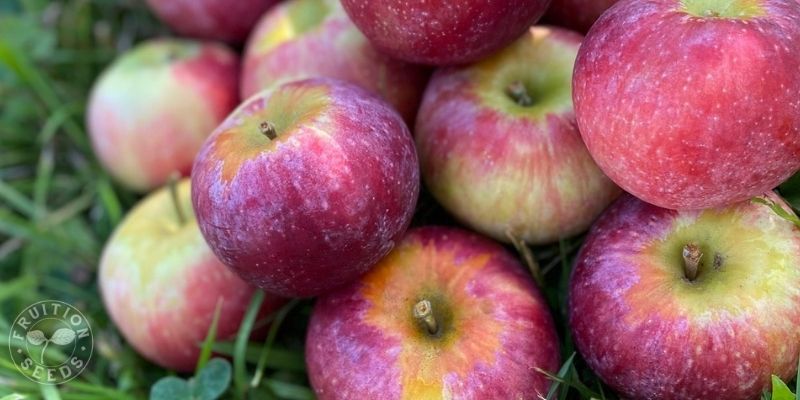
Other important Growing Resources Friends, we at Fruition are not experts on the care & culture of many of the trees we share; your own research and inquiry are the key to your success and we invite you to cultivate your knowledge and share alongside us!
Fruit & Nut Growing Resources from Fruition & Beyond
General Fruit & Nut Tree Growing:
Fruition’s current online tree growing resources are focused on Apple Trees however Pears, Plums, Peaches, Apricots and Cherries require much the same site choice, planting, and basic care considerations.
Fruition’s (Apple) Tree Growing Guide
Fruition’s Free Organic Orcharding Course
Fruition’s pre-recorded Fruit Q & Qs Webinar Library
New England Tree Fruit Management Guide
Cornell’s Guide to Growing Fruit at Home
Cornell’s Tree Fruit Resources
all books by the late Michael Phillips
Apples:
All resources above and…
The Holistic Orchard and The Apple Grower are fabulous books by Michael Phillips.
A Grower’s Guide to Organic Apples from Cornell
Elderberry: University of Vermont
Figs: Penn State Extension
Grapes: Cornell Cooperative Extension
Mulberry: Maine Organic Farmers & Gardeners Association
Pawpaws: Cornell Cooperative Extension
Chinese Chestnut: Arnold Arboretum
Hazelnut: CornellForestConnect
Northern Hardy Pecan: Society of Ontario Nut Growers
And Friends, please join us for future live Fruition Fruit Q&Q webinars here:
Abundance Shared in 2024
The semi-dwarf apples below will be shared Saturday, December 7th at Fruition’s first annual Wassail Celebration! Learn more on our events page.
Semi-Dwarf Apple Trees
36 inch + trees | Mature Height 10-12 Feet | Requires Staking | grafted onto Geneva rootstock
These trees need an Apple variety nearby for pollination… all of the Apples we offer are compatible pollination partners. You’ll find more details on specific disease resistance, culinary uses, harvest times, & cold hardiness HERE
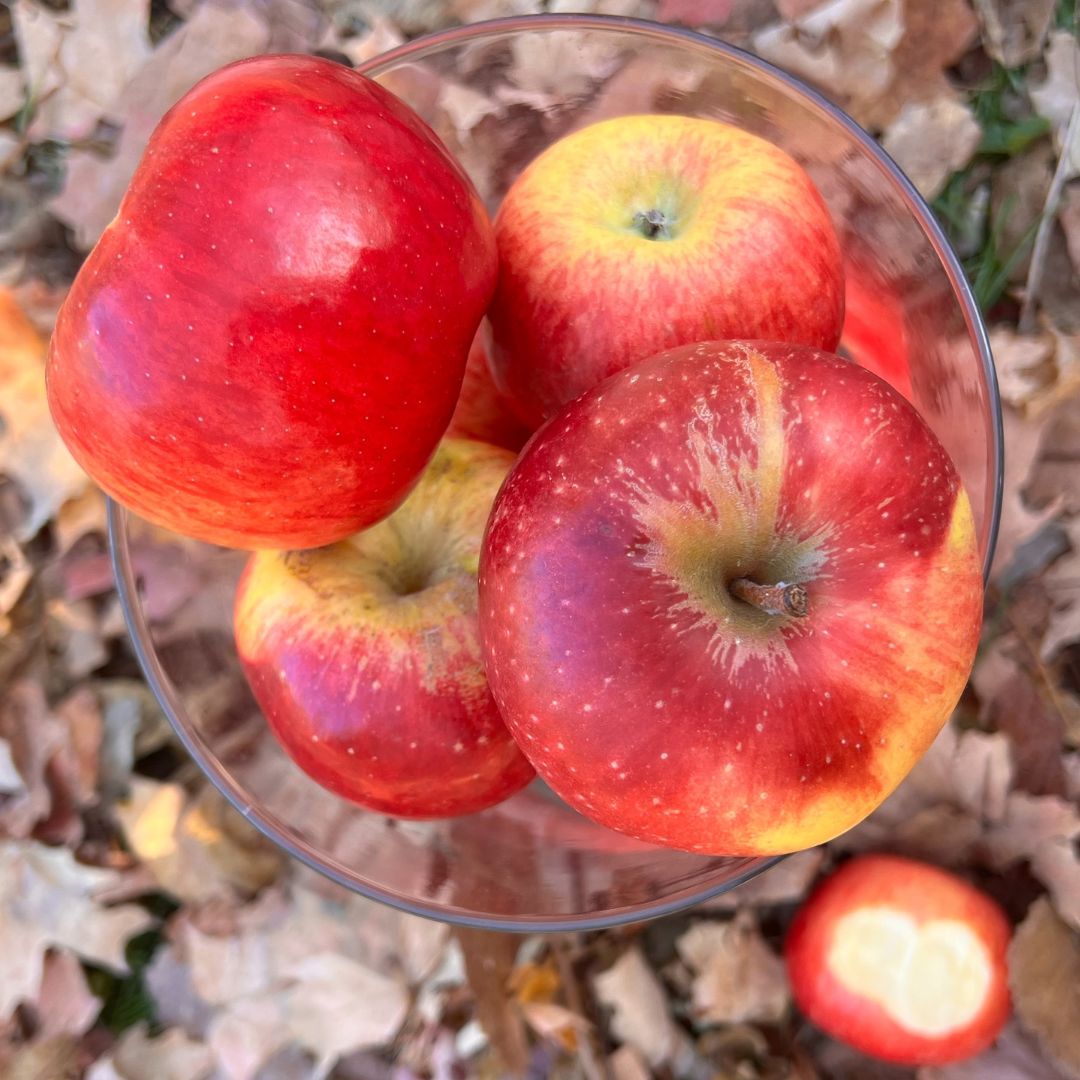
Organic Crimson® Gold Semi-Dwarf Apple Tree
Fresh Eating & Storage | Mid to Late Season Fruit Harvest | Hardy to Zone 5
Crimson® Gold‘s unique aromatic sweetness and bright tart resonates with every crisp juicy bite! Crimson Gold is fondly known as ‘Svatava,’ named for the river flowing between Germany and the Czech Republic. Once in the United States, Svatava was renamed Crimson Gold to celebrate its luminous glow. Crimson Gold has become as famous for its excellent resistance to Apple Scab disease as for its ability to hold in ideal storage for 6 to 8 months.
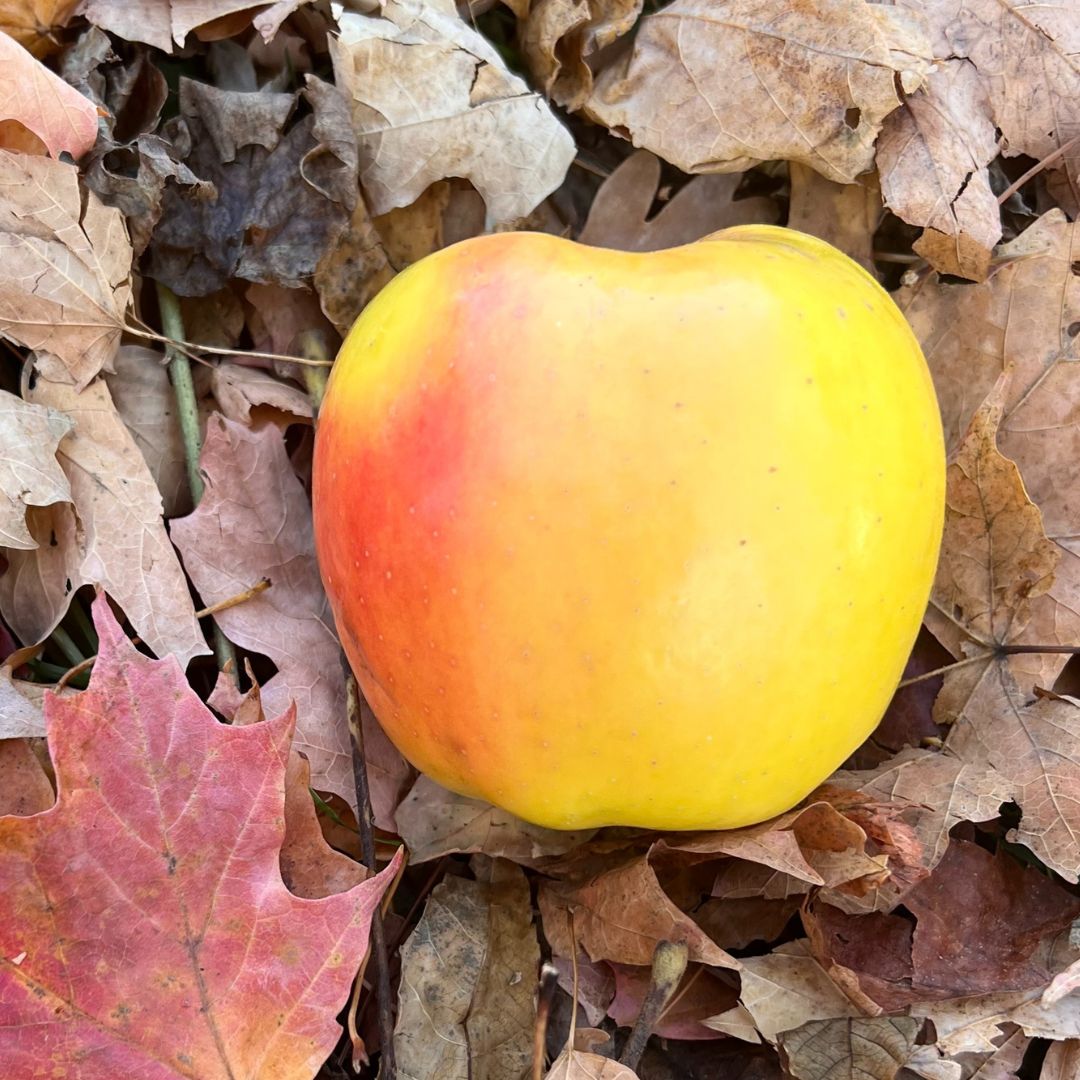
Organic Heliodor™ Semi-Dwarf Apple Tree
Fresh Eating & Storage | Mid to Late Season Fruit Harvest | Hardy to Zone 4
If you like Crispin and Goldrush, you’ll love the bright juicy sweetness of Heliodor! From the Czech Republic, Heliodor translates to ‘gift from the sun’ and is impressively resistant to Apple Scab and Powdery Mildew. Bright yellow fruit blush orange with the sun, their light yellow flesh melding sugar & tart with an incredible crunch. A fabulous storage apple, Heliodor’s flavor arrives 2 weeks after harvest and continues to build, storing up to 4 months in the cellar.
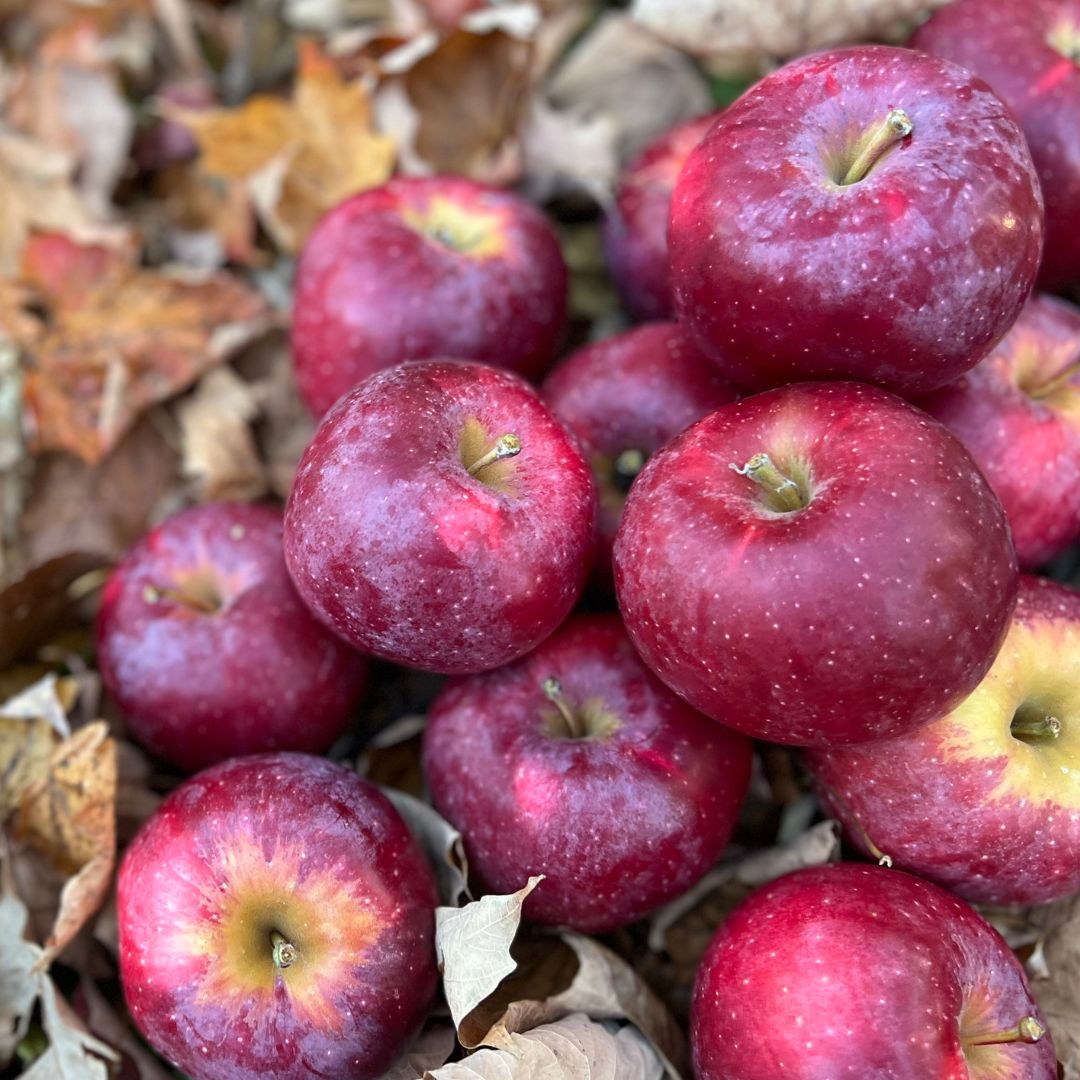
Organic Querina™ Semi-Dwarf Apple Tree
Fresh Eating & Storage | Late Season Fruit Harvest | Hardy to Zone 5
Another deliciously disease-resistant beauty from France, Querina (also known as Florina) is one of the favorites of our tastings with a bright, balanced sweet hailing from the delectable Jonathan in their parentage. With a luscious, juicy crunch, Querina stores up to 3 months and is one of our go-to snacking apples.
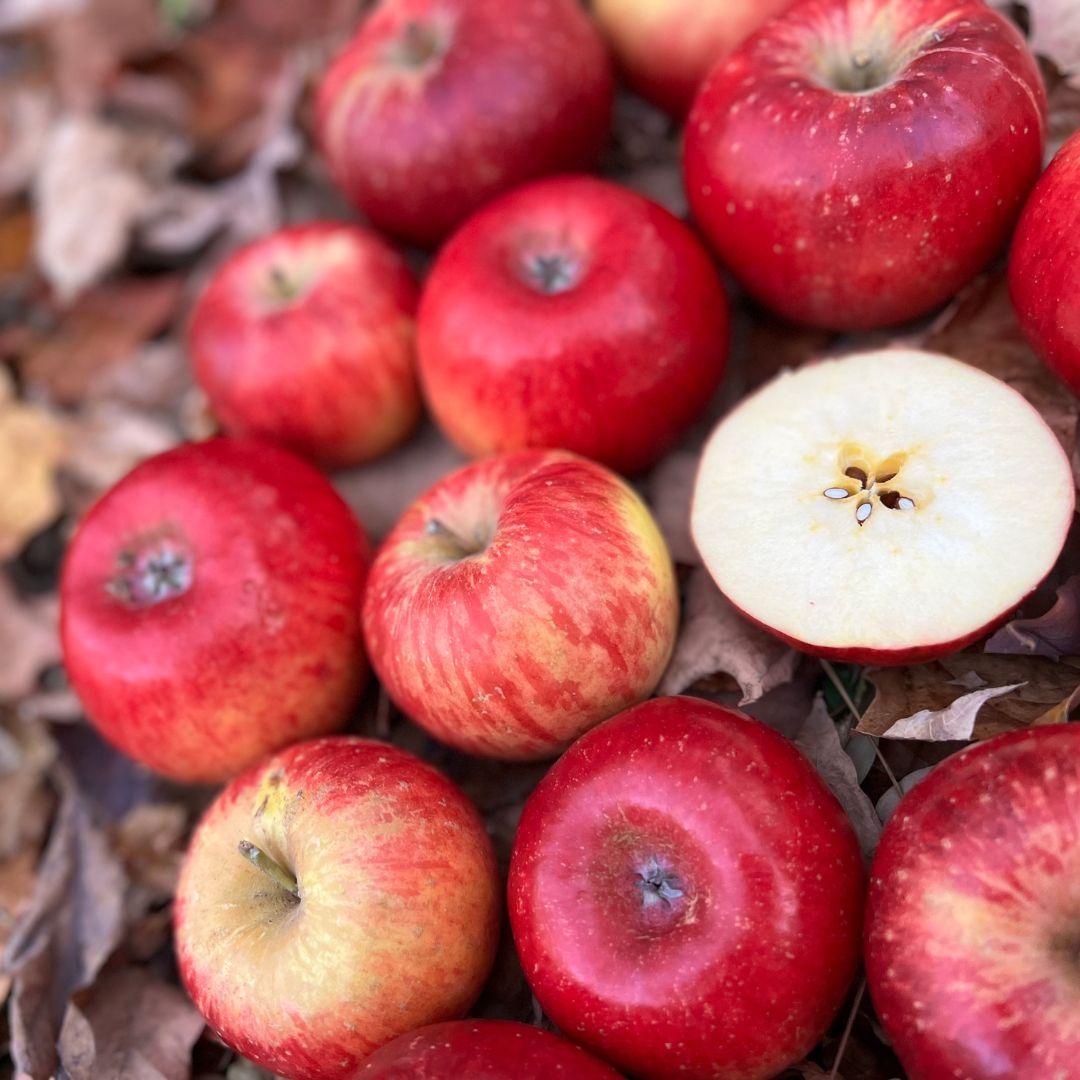
Organic Royal Crimson® Topaz Semi-Dwarf Apple Tree
Fresh Eating & Culinary Dessert | Late Season Fruit Harvest | Hardy to Zone 5
“ooOOoooOoo! that sparkle!’ exclaimed Chelsey at our 2022 tasting! Indeed, Royal Crimson Topaz is one of our new favorite apples, deliciously resilient, beloved for crisp snow white flesh and brilliant sweet-tart scrumptiousness. We love them straight from the tree as well as in apple strudel. Royal Crimson Topaz is slow to turn brown once cut, making it great for salads and pre-cut kid snacks. Crimson Topaz stores 3 to 4 months in the cellar.
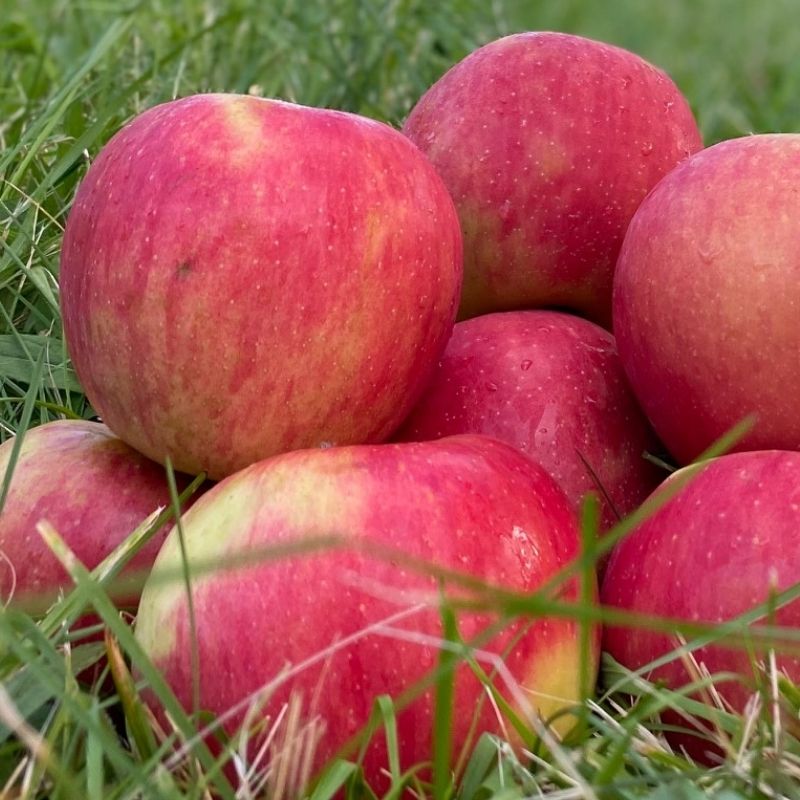
Organic Cordera® Semi-Dwarf Apple Tree
Fresh Eating & Storage | Mid-Season Fruit Harvest | Hardy to Zone 4
Cordera is brilliantly sweet and perfectly tart, gloriously juicy and easy to grow! Cordera hails from the lineage of Honeycrisp and an unnamed relative of Liberty, combining flavor and disease resistance. We fell in love with the bright fruit sweetness and rich aroma, the depth of flavor and fabulous crunch. Excellent Apple Scab disease resistance, ideal for all who wish to spray less or not at all. Cordera fruit also store well into the winter.
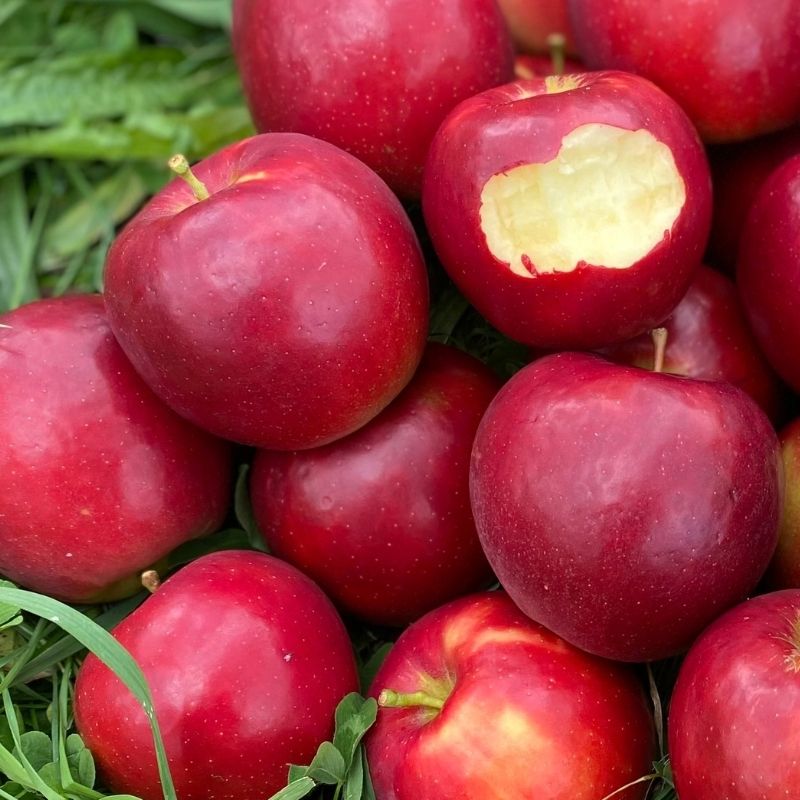
Organic CrimsonCrisp® Semi-Dwarf Apple Tree
Fresh Eating, Sauce & Storage | Mid-Season Fruit Harvest | Hardy to Zone 5
A delightful mid-season dessert apple ripening at the end of September, CrimsonCrisp is iconically round and quite possibly the brightest red apple we’ve seen. Very crisp and juicy flesh, utterly refreshing. Sweet flavor and hints of cherry are balanced by just the right amount of tartness. A scab resistant variety with Jonathan and Rome Beauty parentage, CrimsonCrisp is an excellent option for no spray and organic homeowners & orchards.
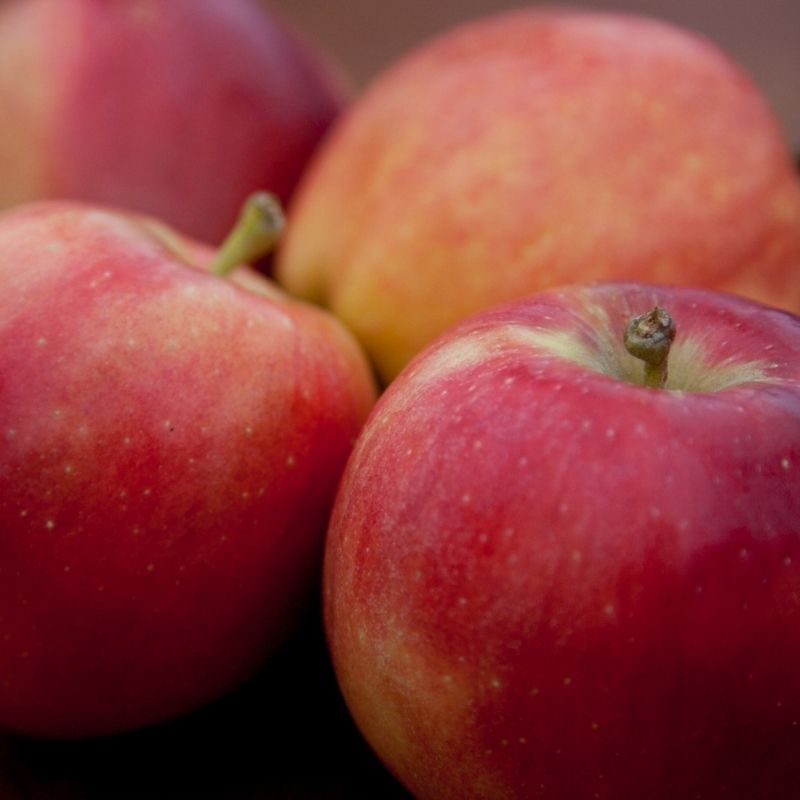
Organic Galarina® Semi-Dwarf Apple Tree
Fresh Eating, Sauce & Storage | Mid-Season Fruit Harvest | Hardy to Zone 4
All lovers of Gala, hail Galarina! Delectably disease-resistant, rich Gala flavor shines through all winter long as sweetness builds in cold storage. Each medium-sized fruit is perfect for snacking with fabulous crunch and glossy thick skin, and easily storing through February. Galarina is the best of both worlds with flavors from Gala and resilience from Querina, including resistance to Apple Scab, Fireblight and Powdery Mildew!
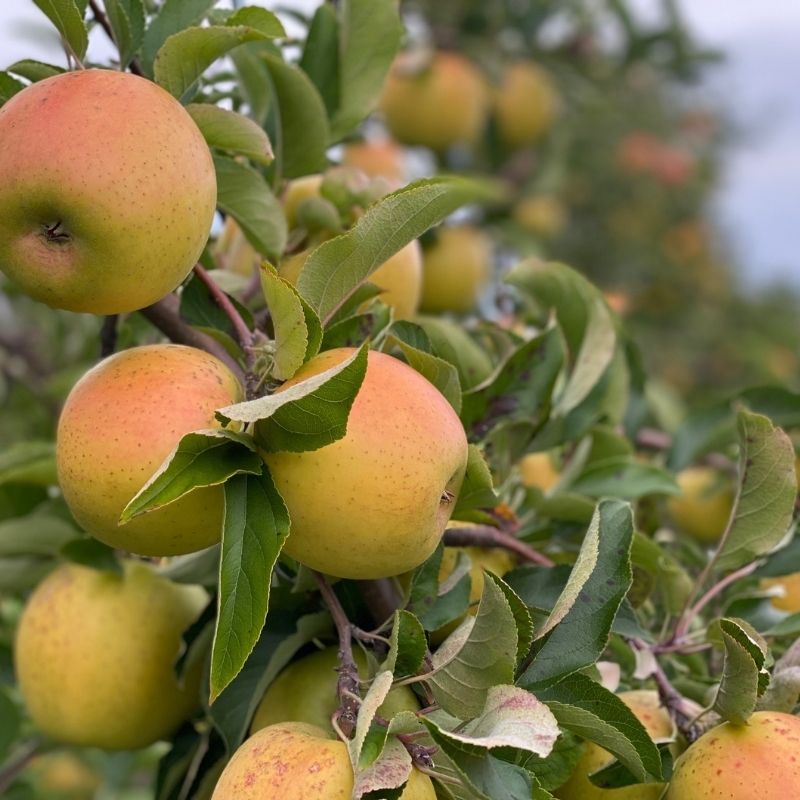
Organic GoldRush Semi-Dwarf Apple Tree
Fresh Eating & Storage | Late Season Fruit Harvest | Hardy to Zone 4
Goldrush is one of the most luscious apples we’ve ever tasted and certainly our favorite winter apple bursting with deep, nuanced sweetness and satisfying crunch! The final apple we harvest in late November, Goldrush gets sweeter, blushing in the cold, undaunted down to 22 F, -6 C. Goldrush is prime December through April lasting through May in the cellar,. Highly resistant to Apple Scab & Powdery Mildew with moderate resistance to Fire blight.
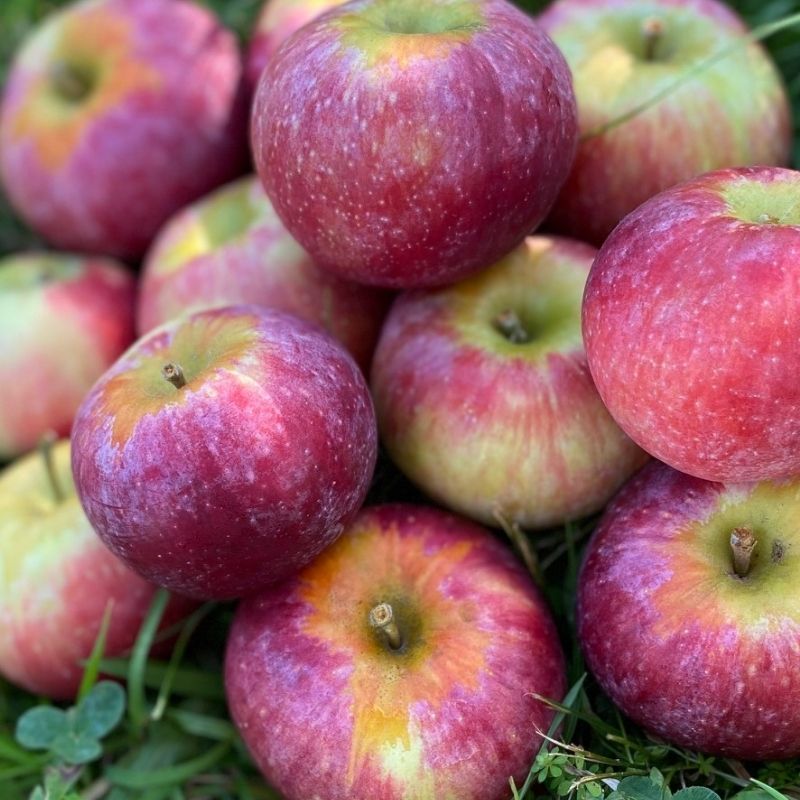
Organic Triumph® Semi-Dwarf Apple Tree
Fresh Eating, Sauce & Storage | Mid-Season Fruit Harvest | Hardy to Zone 4
A luscious cross of Honeycrisp and Liberty, Triumph is incredibly juicy, crisp and sweet with just the right amount of tart. With flavors of ‘honey and elderflower,’ Triumph was described as ‘dynamic’ ‘flavor explosion’ and ‘my new favorite apple!’ Triumph ripens from late September through early October here in Zone 5 and has resistance to apple scab and less susceptibility to bitter pit. So far, no signs of fire blight! Triumph also stores well into the winter.
Asian Pear
Impressively resistant to many fungal diseases, Asian pears are often easier to grow than European pears, especially in short, humid and variable seasons.
Mature Height 15+ Feet | No Staking Required | Self-fertile but more productive with another Asian or European pear nearby
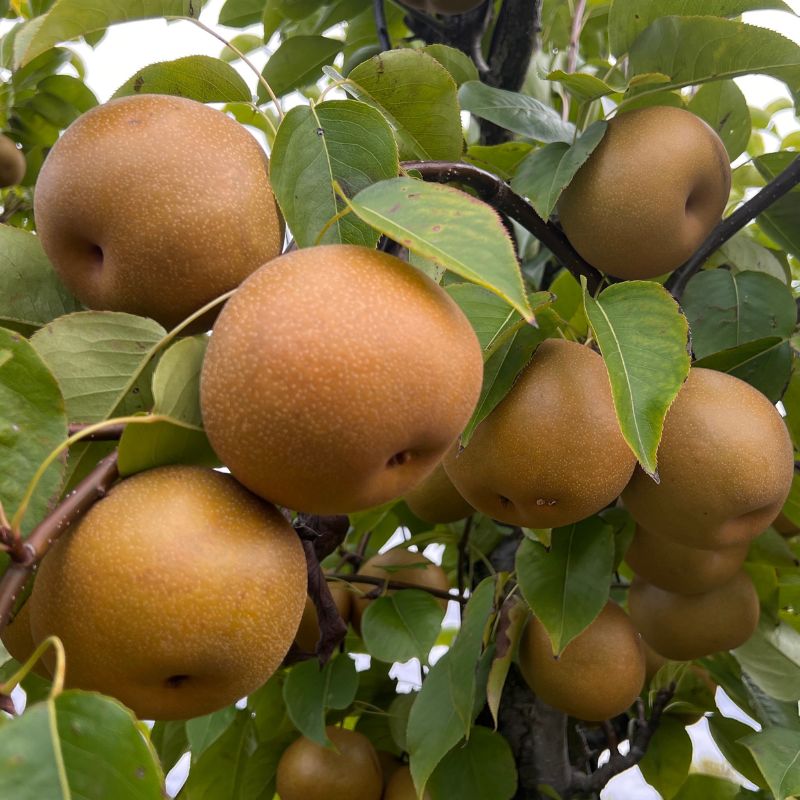
Hosui Standard Asian Pear Tree
Fresh Eating and Baking | August Fruit Harvest | Hardy to Zone 6
A sumptuous dessert Asian pear, Hosui bursts into ivory blooms in spring becoming an abundance of large, round golden brown pears with crisp, juicy flesh so rich and sweet. The beloved ’20th Century’ is one of Hosui’s parents; many people consider both varieties their favorite Asian pears. The leaves of Hosui emerge coppery-bronze in spring and turn brilliant crimson in fall after they ripen their fruit in late August. We love Hosui fresh off the tree and from the fridge for a month after harvest, enjoying them in pies and other baked goods. Though Hosui and all Asian pears are self-pollinating, they will yield larger crops when pollinated with another variety.
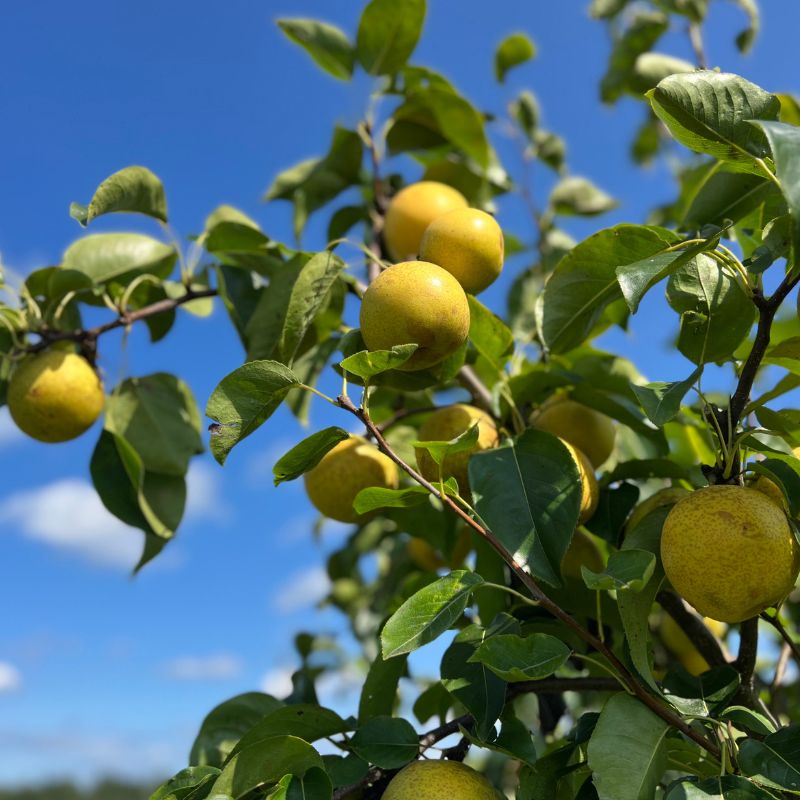
Shinseiki Heirloom Standard Asian Pear Tree
Fresh Eating, Baking & Storage | Late August, Early September Fruit Harvest | Hardy to Zone 6
Shinseiki is heavy-bearing and beautiful with delicately sweet and creamy, fine-grained flesh. Also called New Century, Shinseiki is a beloved dessert Asian pear thriving in cold as well as hot seasons and stores up to 5 months in the fridge. Luminous copper foliage in spring bursts into profusions of cream flowers maturing golden yellow pears in August, leaves turning crimson in the autumn cold. Though Shinseiki and all Asian pears are self-pollinating, they will yield larger crops when pollinated with another variety.
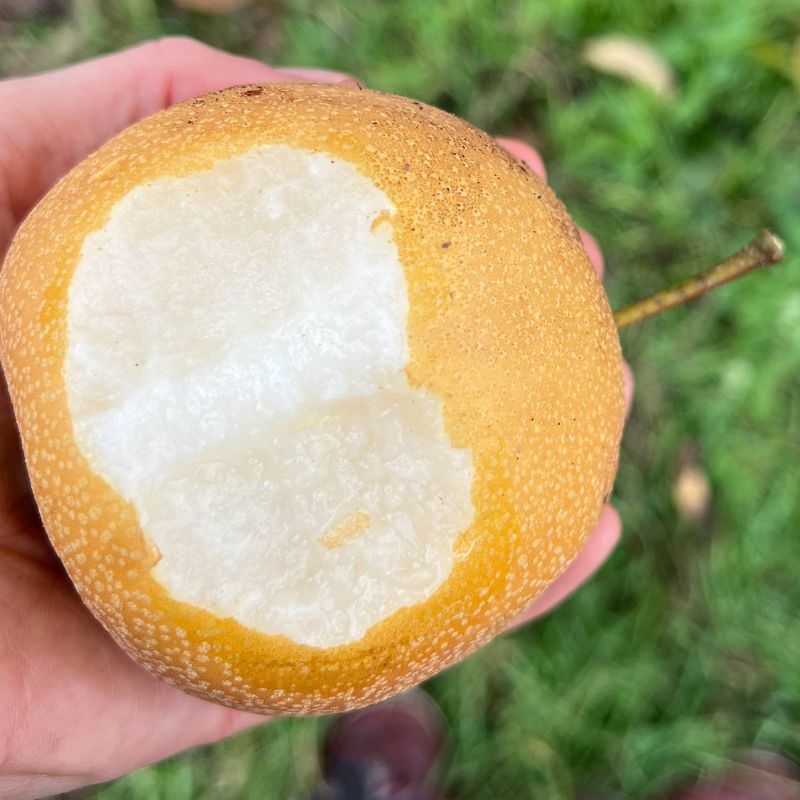
20th Century Heirloom Asian Pear Tree
Fresh Eating, Baking & Storage | Late August Fruit Harvest | Hardy to Zone 6
Juicy sweet and deliciously crisp, 20th Century bears abundance earlier than many other varieties and has been one of the most popular Asian pears for well over a century. Originally a seedling fostered by a 13-year-old farm boy in Japan, the delectably disease-resistant fruit came of age at the turn of the century and became immensely popular, inspiring the name. The original tree was designated as a national monument in 1935 only for its historic orchard to be burned in an air raid in 1944. A monument memorializes the tree today in a small playground called 20th Century Park. Though 20th Century and all Asian pears are self-pollinating, they will yield larger crops when pollinated with another variety.
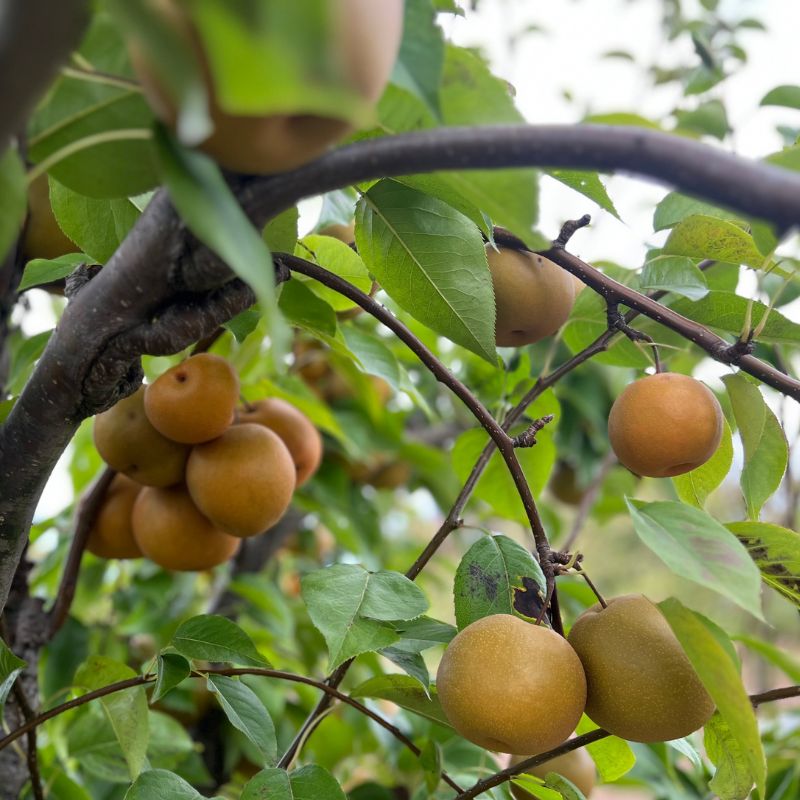
Olympic Standard Asian Pear Tree
Fresh Eating, Baking & Storage | Mid to Late Season Fruit Harvest | Hardy to Zone 5
Olympic is marvelously flavorful as well as massive, each fruit often weighing one pound or more. We love Olympic fresh off the branch as well as baked into pies and cobblers, their crisp butterscotch sweetness holding marvelously up to 6 months in the fridge. Often bearing fruit in their third year, this impressive variety is also fondly known as Korean Giant. Though Olympic and all Asian pears are self-pollinating, they will yield larger crops when pollinated with another variety.
Seedlings – Pawpaws, Figs, & Nuts
Pawpaw Seedling
Hardy to Zone 5 | Mature Ht 25-35 ft | 2 Seedlings Recommended | Asimina triloba
This native tree bears much sought after yellow-green skinned fruit tasting like a banana, pineapple and mango custard. Mature Pawpaw trees will deliver diverse fruit size and flavors, with the random promise of discovering you have the world’s best Pawpaw in your backyard. Lovely as a landscape tree. For good pollination, we recommend planting 2 seedlings close together to form a Pawpaw patch.

Fig Potted Plant
Hardy to Zone 5 | Mature Height 8-20 ft | No Staking Required | Self-pollinating | Ficus carica
Figs in short seasons! Regional adaptation is everything and a little care can surround you with a lot of figs, even here in Zone 5. We’re honored to share cuttings from several cultivars including Longue D’Aout, Ventura and Chicago Hardy.
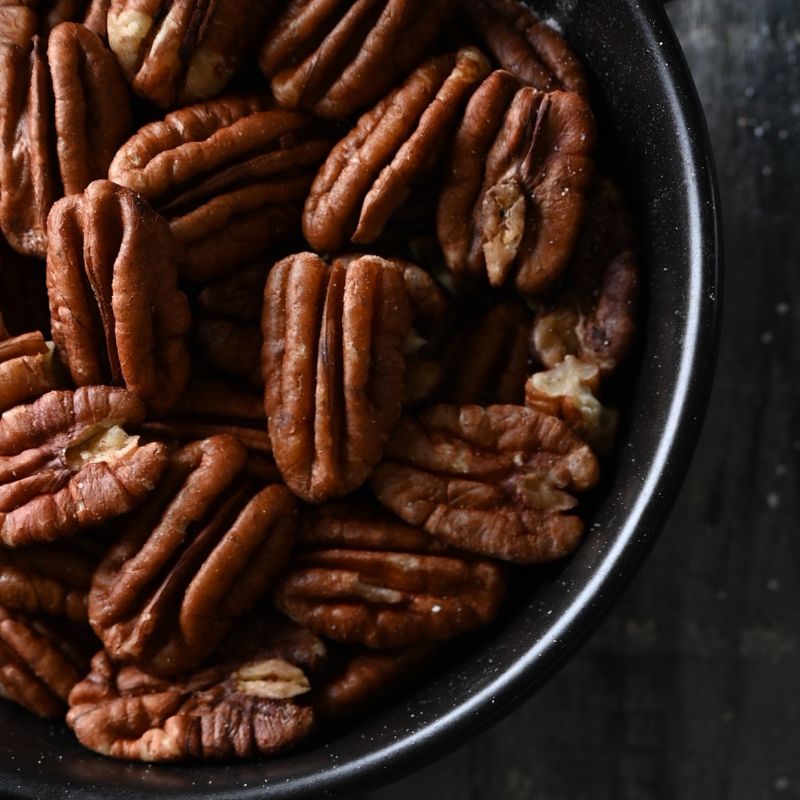
Northern Hardy Pecan Seedling
Hardy to Zone 5 | Mature Ht 30-50 ft | No Staking Required | Needs 2 seedlings to pollinate | Carya illinoinensis
Regional adaptation makes all the difference! We’re honored to share these resilient, delectable and beautiful Northern Hardy Pecan seedlings with you and with us all, nourishing our communities for generations to come. Our friend Jeff has been growing these seedlings of Kanza and Major strains (among others) in Honeoye, selecting for early vigor, cold hardiness and deliciousness. Each northern hardy pecan seedling is 6 to 12 inches tall.
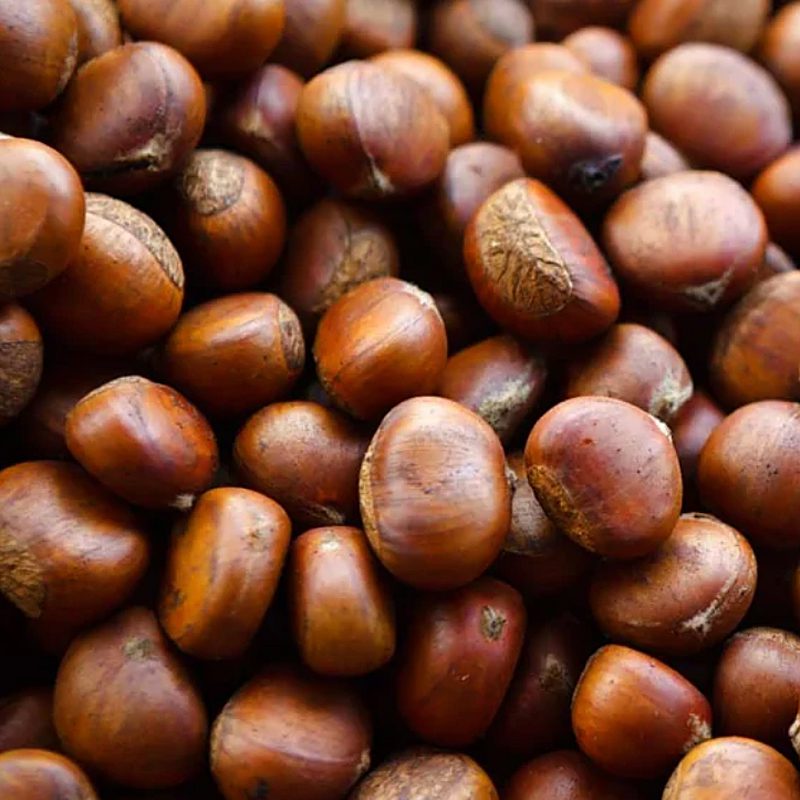
Chinese Chestnut Seedling
Hardy to Zone 5 | Mature Ht 40-60 ft | No Staking Required | Needs 2 seedlings to pollinate | Castanea mollissima
Renowned for the quality of its nuts, Chinese Chestnuts are fast growing, heavy bearers of “tree urchins” that contain generally larger nuts than the American Chestnut. When mature, the Chinese Chestnut tree is a wider branching tree than the American Chestnut, suitable for shade & for attaching swings. Has shown good general resistance to Chestnut Blight, but resistance level is variable in seedlings. Fruition’s Chinese Chestnuts are 1-2 foot seedlings.
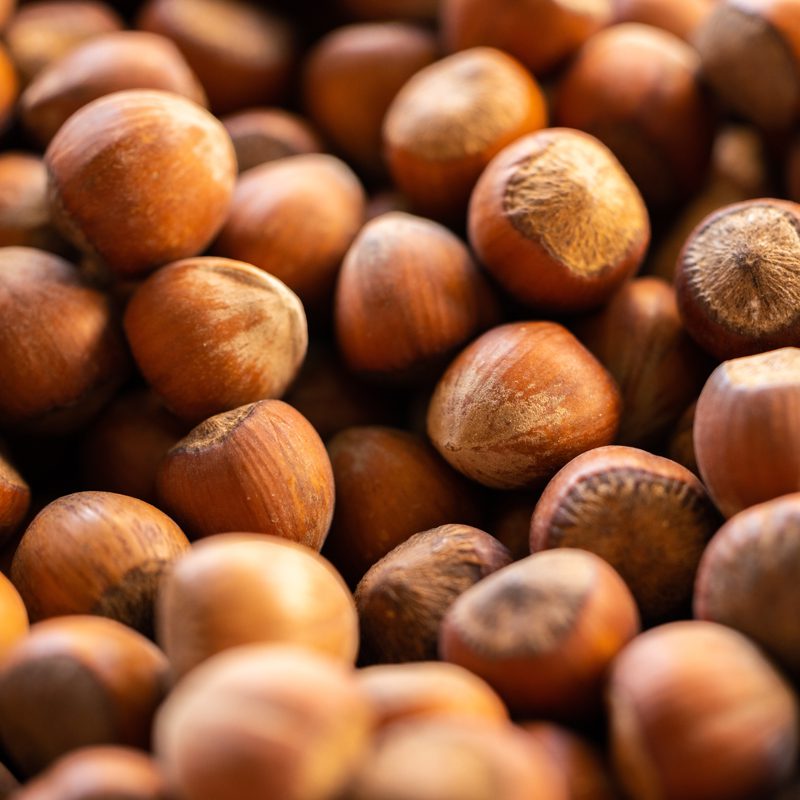
Yamhill Hazelnut Seedlings
Hardy to Zone 5 | Mature Ht 6-10 ft | Needs 2 seedlings to pollinate | Corylus americana
Yamhill hazelnuts are exceptionally abundant as well as early maturing and highly resistant to Eastern Filbert Blight. An excellent pollinizer for other varieties, Yamhill is also more insect-resistant than common hazelnuts. Hardy to Zone 5, our resilient seedlings are 6 to 12 inches tall with strong roots ready to surround you with abundance! Hazels often start producing by year 3 and often offer a gallon of nuts by year 5, growing more abundant for many years.




Jefferson Hazelnut Seedlings
Hardy to Zone 5 | Mature Ht 6-12 ft | Needs 2 seedlings to pollinate | Corylus americana
Delicious! Hardy to Zone 5, Jefferson hazelnut trees are one of the most popular varieties of commercial hazelnut growers. Yamhill and Jefferson Hazelnuts are often planted together for cross-pollination, since Jefferson needs another variety to pollinate and produce their large nuts with prodigious yields. Our resilient seedlings are 6 to 12 inches tall with strong roots ready to surround you with abundance! Hazels often start producing by year 3 and often offer a gallon of nuts by year 5, growing more abundant for many years.
Heirloom Apple Trees
Fruition’s Semi-dwarf Heirloom apple trees require staking and another Apple variety nearby for pollination.
All Heirloom Apples are 2-year old, non-organic, bare-root nursery stock.
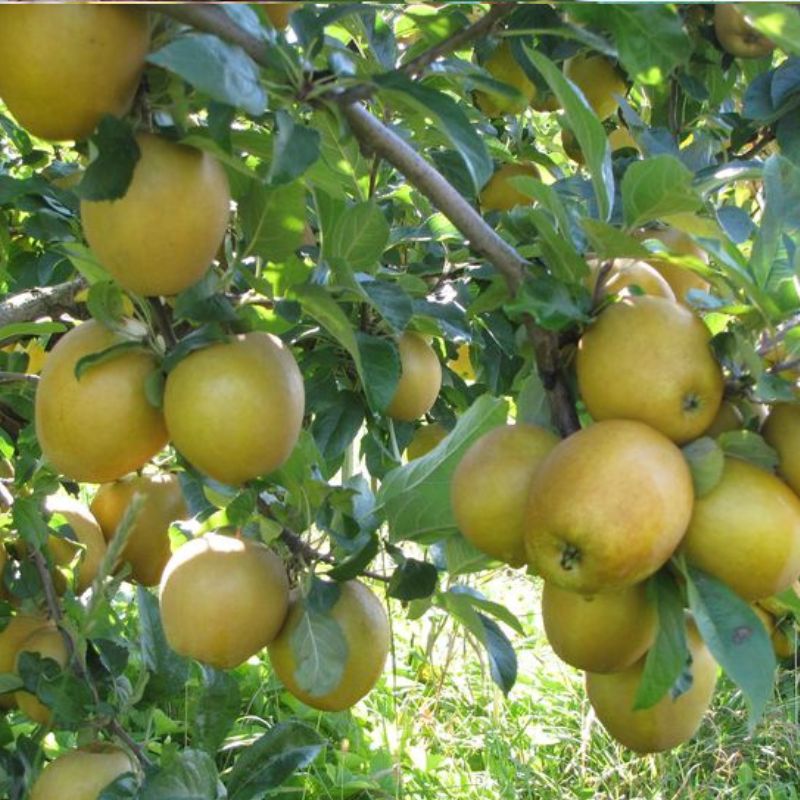

Hudson’s Golden Gem Heirloom Semi-Dwarf Apple Tree
Fresh Eating, Baking, Cider, Storage | Mid-Season Fruit Harvest | Hardy to Zone 3
A serendipitous chance seedling discovered in an Oregon fencerow, Hudson’s Golden Gem has been blowing people’s minds since 1931. The large and tapered-conical fruit with full yellow-brown russet skin reveals a crisp apple flavored and textured like Bosc pear. Confusion is the most common first-take: is this a pear, or an apple….or both??? These are questions that can only be answered by many more bites! Overall good resistance to Apple Scab, Mildew and Fireblight.
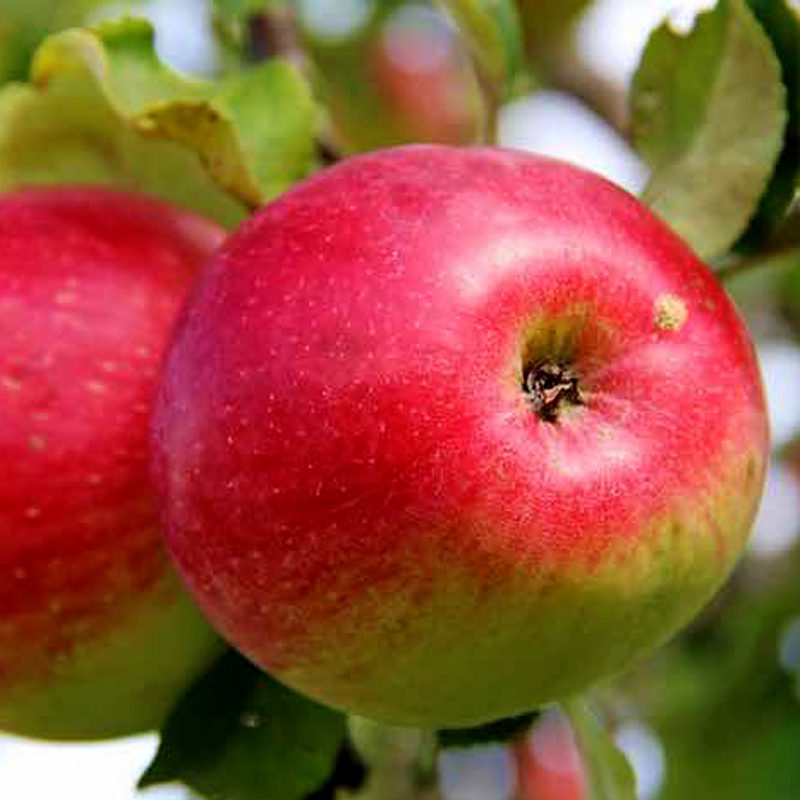

Wealthy Heirloom Semi-Dwarf Apple Tree
Fresh Eating & Baking | Hardy to Zone 3
Hardy to Zone 3, super juicy with a luscious sweet-tart balance, Wealthy is a perfect early ripening apple for fresh eating and baking. Peter Gideon crossed two cold-hardy apples he loved in 1868 and named the subsequent marvel in honor of his wife, Wealthy Gideon. A very cold hardy and reliable variety, with good all-around disease resistance.
Grapes
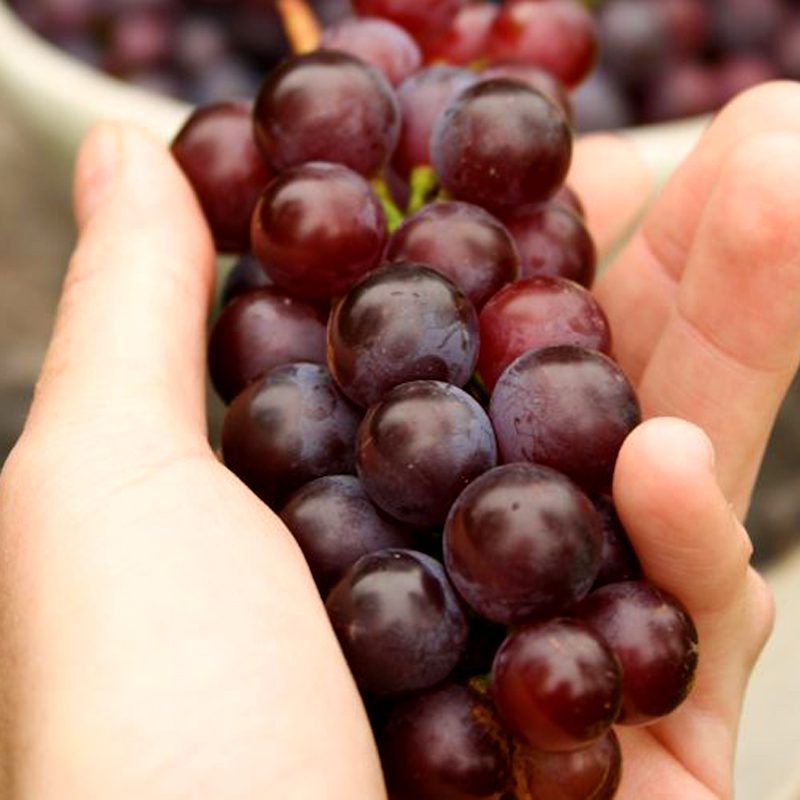

Catawba Heirloom Grape
Wine-making, fresh eating, juice, jelly | Self-fertile | Vitus labrusca
In the mid 1800s, Catawba Grape was widely grown in Central New York for making sparkling wine, before the Concord grape rose to fame. Obviously proven for wine-making, this purple-red slipskin grape variety is also good for fresh eating, juice, jelly. Late ripening, with spicy sweet flavor. Catawba has seeds, like all good old-fashioned grapes!
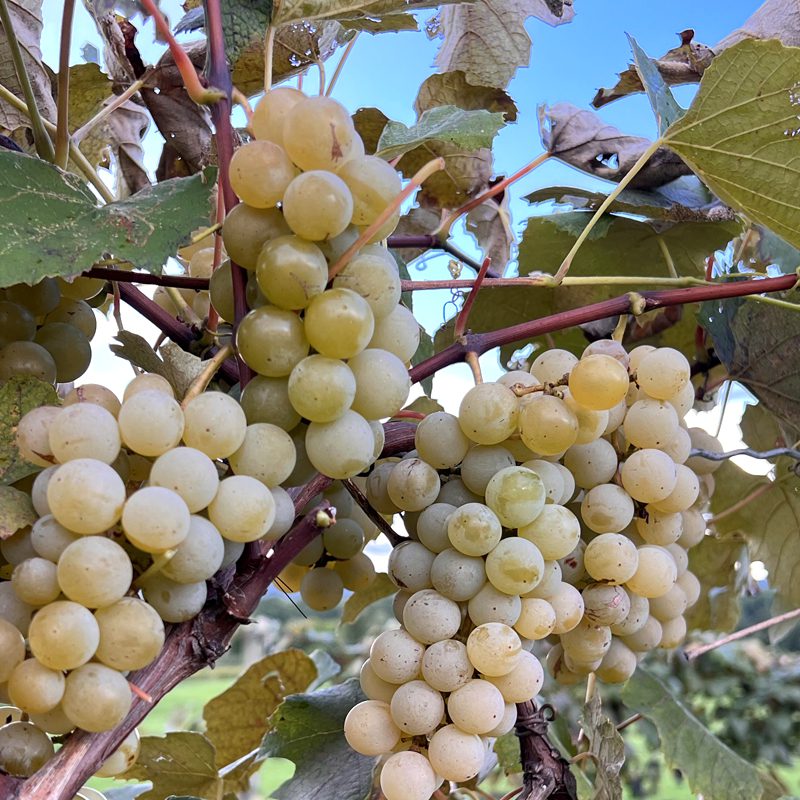

Niagara Heirloom Grape
Fresh eating, juice, jelly, sweet wine | Self-fertile | Vitus labrusca
Niagara Grape was discovered in the late 1800s as a green fruited (aka “white”) mutation from Concord grape. It is well-liked as an eating grape, as well as for white grape juice, jams, jellies and sweet white wine. Niagara has seeds, like all good old-fashioned grapes!
Sold Out During Pre-Order:
Apricot Trees
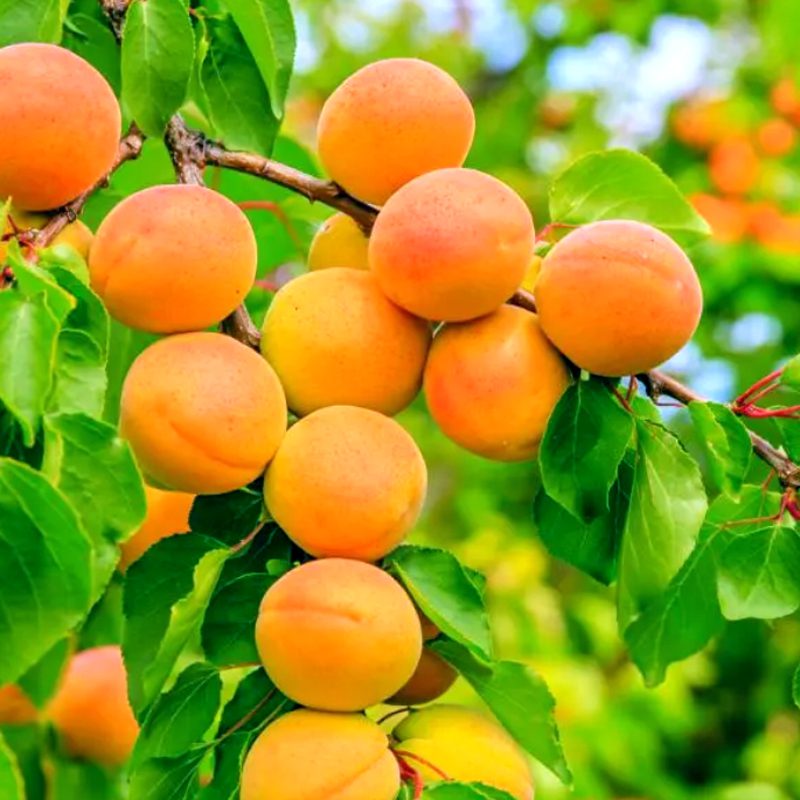

Precious Heirloom Standard Apricot Tree
Hardy to Zone 5 | Mature Ht 12-18 ft | No Staking Required | Self-pollinating
We’re blown away by the earliness and resilience of luscious Precious Apricot each summer. The original mother tree was discovered over 100 years ago in Ontario. Research has discovered Precious is the result of a natural crossing between Almond and Apricot, giving it cold hardiness, good general disease resistance AND also an edible almond-like seed within the pit. Precious Apricot trees are 2-year old, non-organic, bare-root nursery stock.
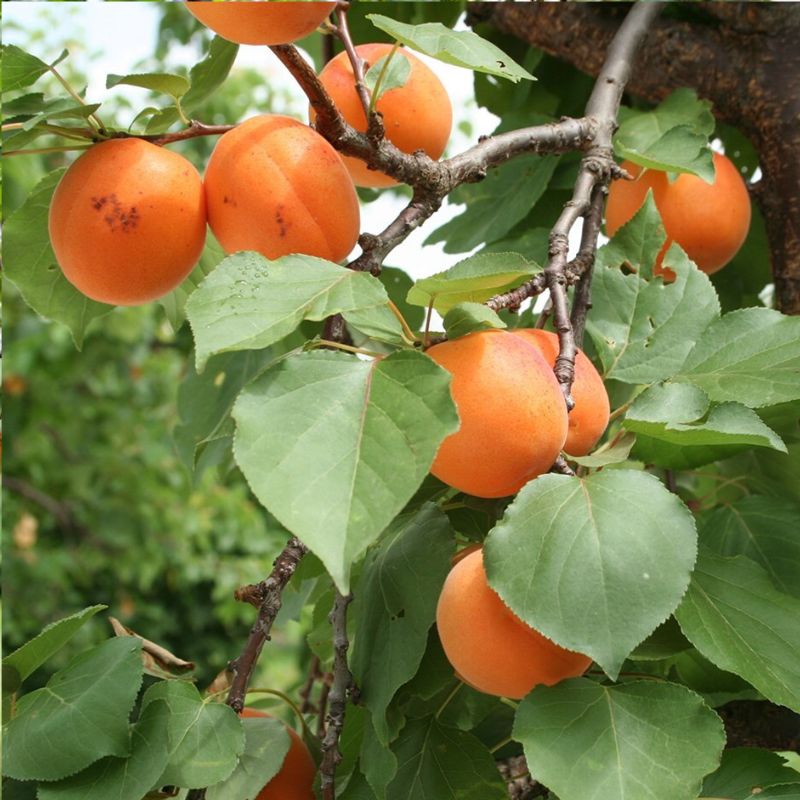

Alfred Standard Apricot Tree
Early to Mid August Harvest | Hardy to Zone 4 | Mature Ht 12-18 ft | No Staking Required | Self-pollinating
Alfred Apricot embodies all your glowing orange, sweet, juicy, delicious apricot expectations. Hard to say more when the joy of eating an apricot from your own tree arrives! Our Alfred Standard Apricot Trees are 2-year old, non-organic, bare-root nursery stock. This variety is self-fertile, meaning no additional apricot varieties are needed nearby for pollination.
Cherry Trees
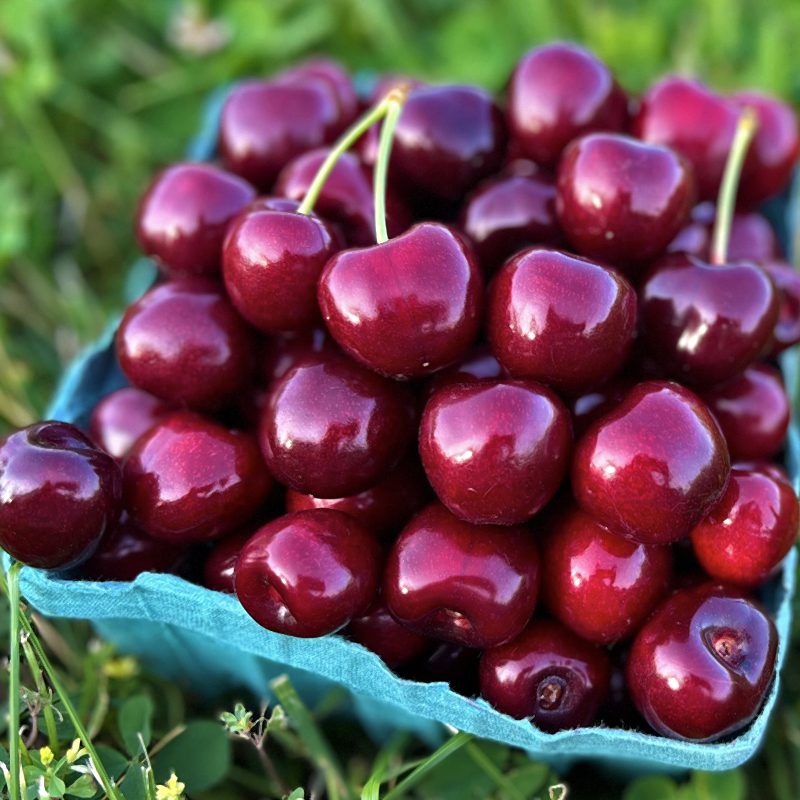

BlackGold® Semi-Dwarf Sweet Cherry
Hardy to Zone 5 | Mature Height 18-25 ft | No Staking Required | Self-pollinating | Prunus avium
Ohhhhh these cherries! Ripening in late June and early July, their juicy sweetness is everything we love about summer. Released from Cornell in 2001, BlackGold is hardy to Zone 5, blooms late to thwart frost and resists many common cherry diseases, as well. (This quart of fresh-picked BlackGold cherries did not last long, you’re right!). Fruition’s BlackGold Semi-Dwarf Sweet Cherry trees are 2-year old, non-organic, bare-root nursery stock.
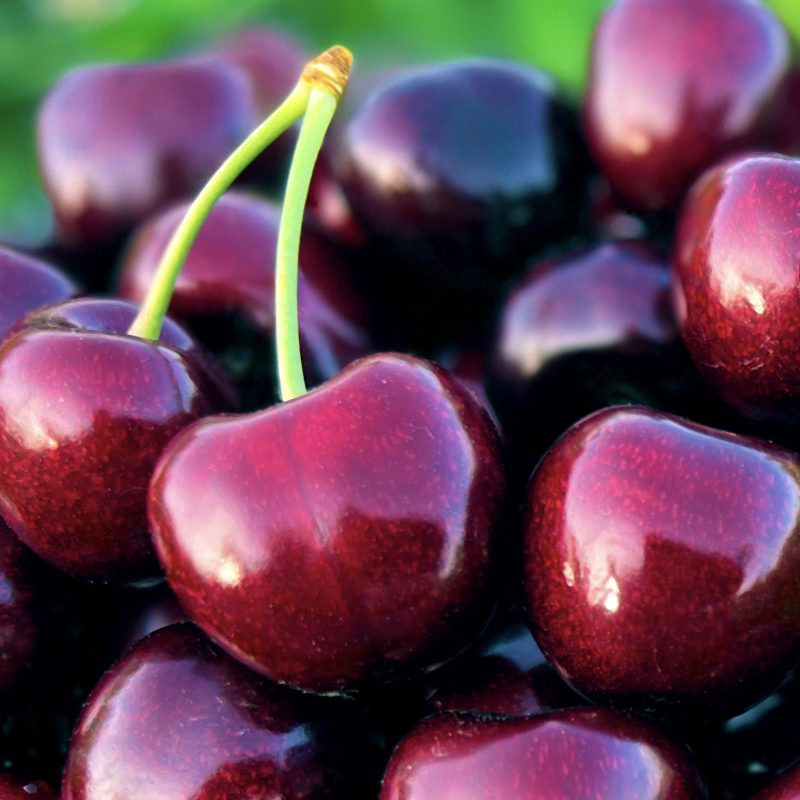

Jubileum™ Standard Tart Cherry
Hardy to Zone 5 | Mature Height 18-25 ft | No Staking Required | Self-pollinating | Prunus avium
We love tart cherries as well as sweet and Jubileum is the best of both worlds! We love to munch these warm from the branches as well as baked into pies. So juicy, so rich and also so abundant, thanks to their impressive disease resistance. Fruition’s Jubileum Tart Cherry trees are 2-year old, non-organic, bare-root nursery stock.
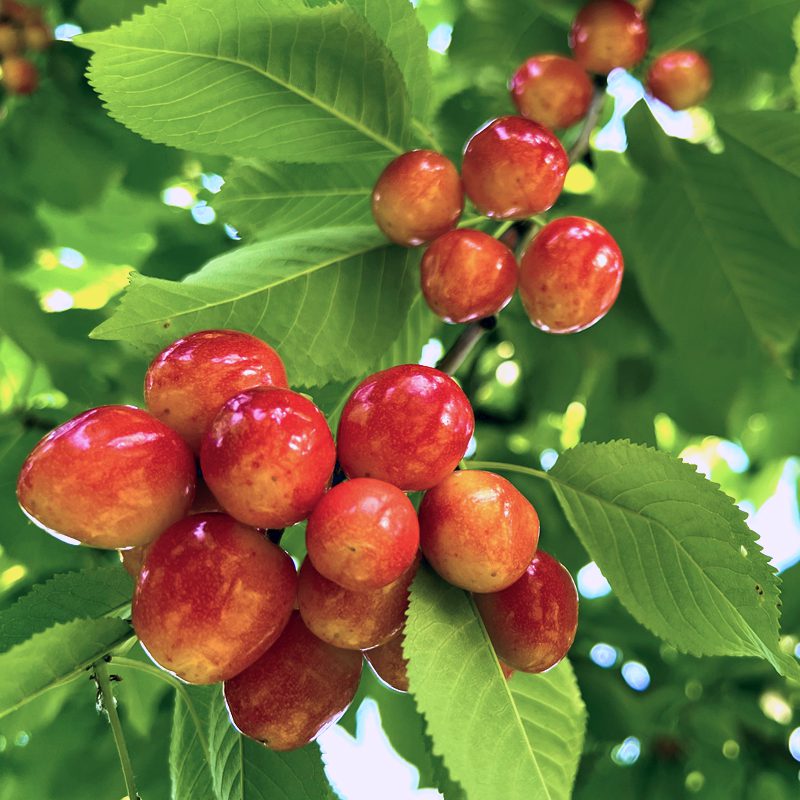

WhiteGold® Semi-Dwarf Sweet Cherry
Hardy to Zone 5 | Mature Height 18-25 ft | No Staking Required | Self-pollinating | Prunus avium
Imagine bright tropical sweetness paired with rich cherry: We’ve never tasted such a luscious cherry! Ripening in late June and early July, their juicy abundance is heaven on earth. Released from Cornell in 2001, WhiteGold is hardy to Zone 5, blooms late to thwart frost and resists many common cherry diseases, as well. Fruition’s WhiteGold Semi-Dwarf Sweet Cherry trees are 2-year old, non-organic, bare-root nursery stock.
Elderberry Shrubs
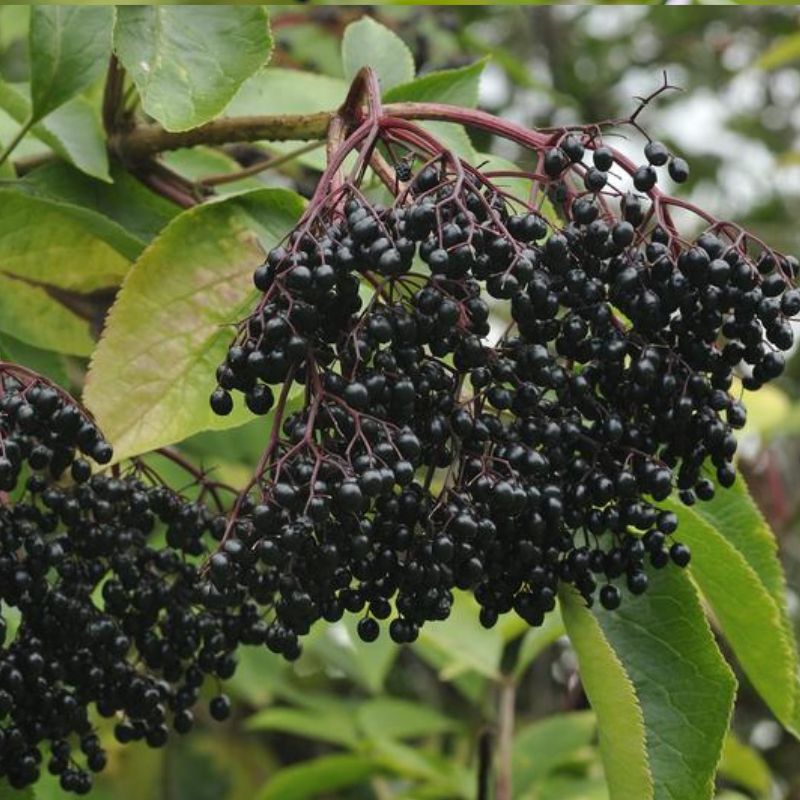

Elderberry
Hardy to Zone 4 | Mature Height 8-14 ft | No Staking Required | Self-pollinating | Sambucus canadensis & nigra
One of the easiest fruits to grow, Elderberry is deep, delicious medicine both as flower and fruit. Quickly growing 10+ tall, elderberries are phenomenal habitat for beneficial birds and pollinators. We see elderberries thriving in diverse soils and sun, tolerating more moisture than many other shrubs.
Grapes
Fruition Grape plants are self-fertile, meaning a plant can produce grapes without another grape variety nearby.
All are non-organic, bare-root nursery stock.
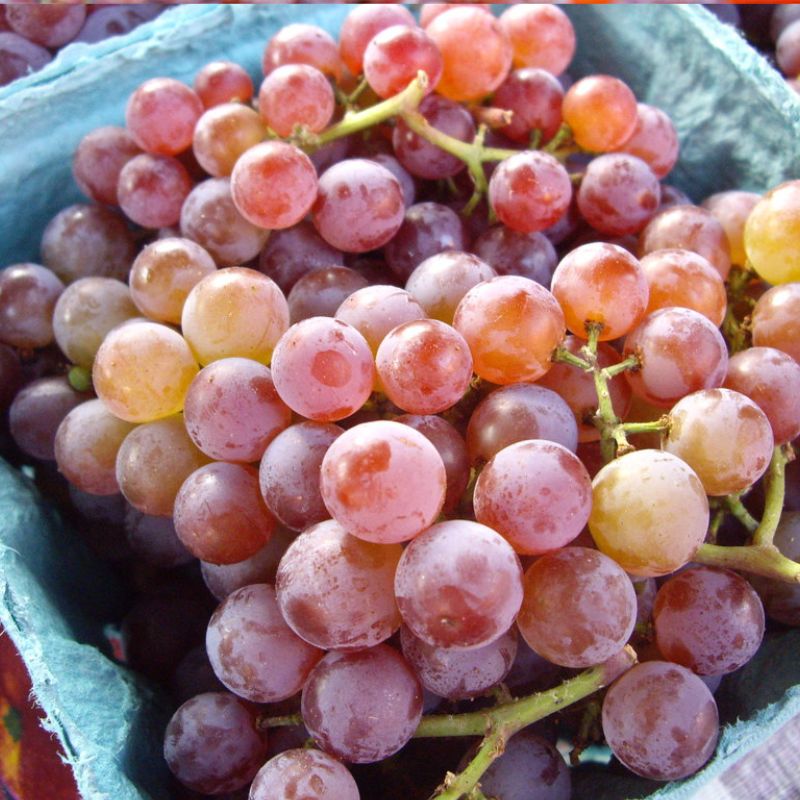

Canadice Seedless Grape
Fresh eating, juice, jelly, wine-making | self-fertile | Vitus labrusca
Seedless and ohhhh so sweet, Canadice Seedless Grape has been one of Petra’s favorite grapes since childhood. Released from Cornell in 1977, Canadice is early and abundant, ripening in glowing dusty rose clusters late August through September and is hardy to -20F. Savoring Canadice grapes straight off the vine is divine as well as tucking them into salads. We also love to juice and turn them into jelly: the color is gemstone and the flavor is sublime!
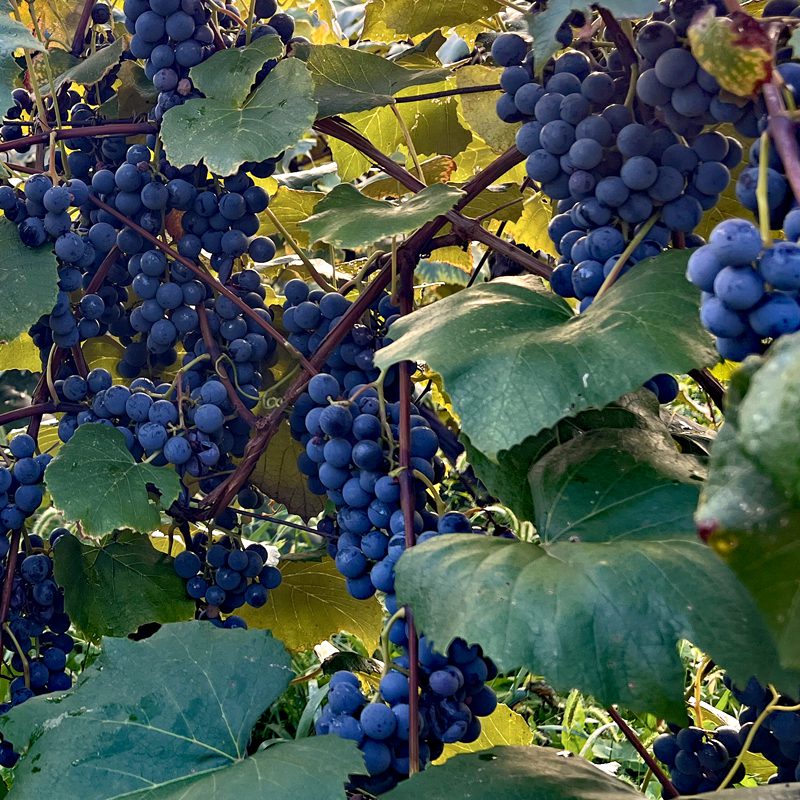

Glenora Seedless Grape
Fresh eating & jelly | Self-fertile | Vitus sp
Glenora Seedless Grape has graced Finger Lakes tables for generations! Ripening seedless blue clusters that are wonderful for fresh eating and jelly making. Glenora also has good general resistance to common fungal diseases.
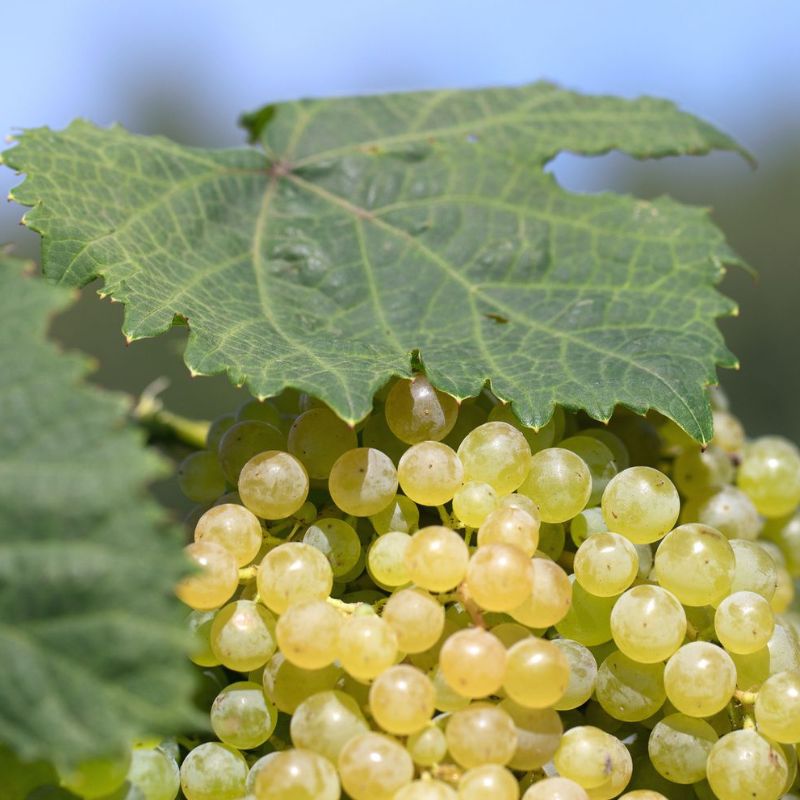

Himrod Seedless Grape
Wine-making, fresh eating, juice, jelly | Self-fertile | Vitus labrusca
Lusciously sweet and scrumptiously seedless, Himrod has graced the tables of the Finger Lakes for generations. Released by Cornell in 1952, Himrod is hardy to Zone 4, impressively abundant and keeps for weeks in the fridge after harvest. The combination of Himrod and Canadice grapes are among the finest gifts of September.
Mulberry Tree Seedlings


Red Mulberry Seedling
Jams, jellies, syrups, wines, fresh eating | Hardy to Zone 5 | Mature Ht 30-50 ft | No Staking Required | Self-pollinating*
We have big stained purple hearts for Red Mulberry! Native to Eastern and Southeast US, hardy and resilient, she grows back from cold or other damage. And wait, you’re telling me there’s a tree that bears fruit like blackberries but there are no thorns?! Fruition’s Red Mulberries are 1-2 foot seedlings. *Most Red Mulberry Seedlings are self-fertile, meaning no additional mulberries are needed nearby for pollination, but we recommend planting 2 seedlings because of a fun and random chance of getting an all “pollen receiving” or “pollen giving” seedling.
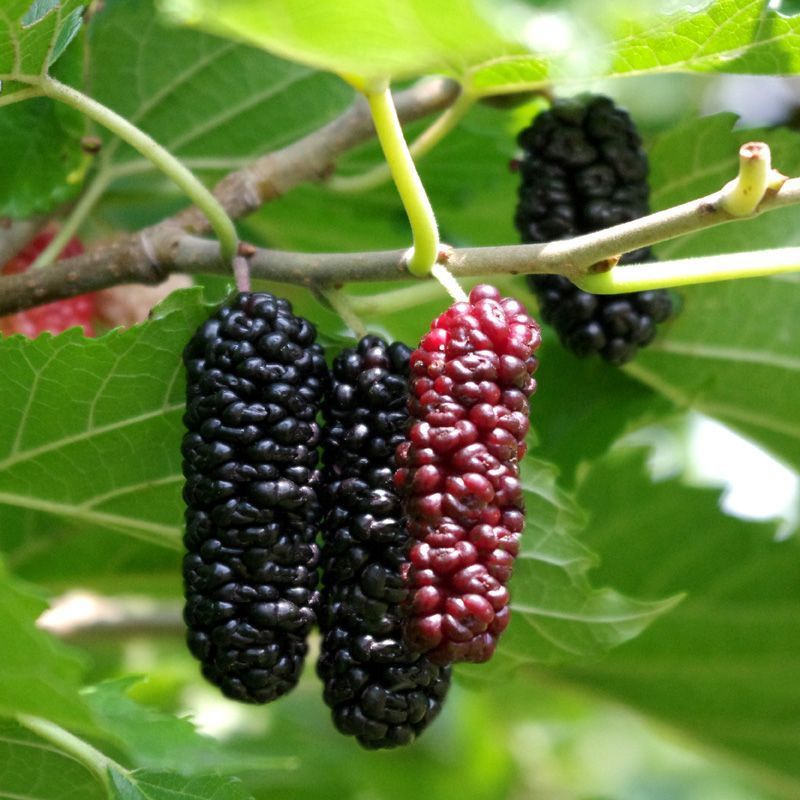

Illinois Everbearing Mulberry Trees
Fresh eating, jams, jellies, wines | August thru September Harvest | Hardy to Zone 5 | Mature Ht 20-30 ft | No Staking Required | Self-pollinating
Quickly growing 20 to 30 feet tall, this welcoming shade tree also doubles as the best “blackberry” patch you’ve ever dreamed of! Illinois Everbearing Mulberry is prized for its sublime flavor and extraordinary productivity as well as dreamy, enveloping branches and lush foliage. Their 1″ to 2″ purple-black fruits are irresistible, and their purple-ling of your hands & mouth will tell everyone where you’ve been….in Heaven of course! Fruition’s Illinois Everbearing Mulberries are 1-2 foot own-root propagated trees.
Nut Trees




Finger Lakes Hazelnut Seedling
Hardy to Zone 4 | Mature Ht 6-12 ft | Needs 2 seedlings to pollinate | Corylus americana
Finger Lakes Hazelnut! This disease resistant and productive strain of native American Hazelnut was originally selected over the course of 25 years by Dawn and Jeff Zarnowski of New York. With generally large sized nuts and possible resistance to filbert blight (variable resistance levels per each seedling), we can all enjoy hazelnuts locally selected and locally grown. Fruition’s Finger Lakes Hazelnut are 1-2 foot seedlings.
Northern Hardy Peach Trees
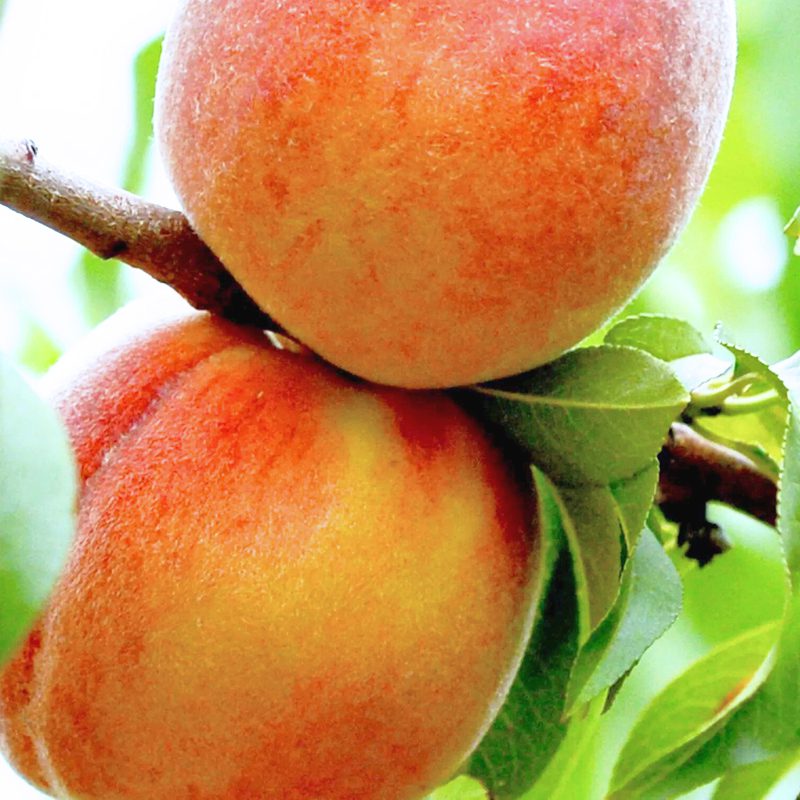

Contender Standard Peach Tree
Hardy to Zone 4 | Mature Ht 15-20 ft | No Staking Required | Self-pollinating | Prunus persica
Definitely a Contender for your affections, Contender Peach is a very cold hardy, very disease resistant and oh-so-yummy freestone peach is perfect eaten off the tree, canned or frozen. The smooth, sweet sparking tangy yellow flesh is a great Summer reward for….being smart enough to plant a tree or two! Fruition’s Contender Peach trees are 2-year old, non-organic, bare-root nursery stock.
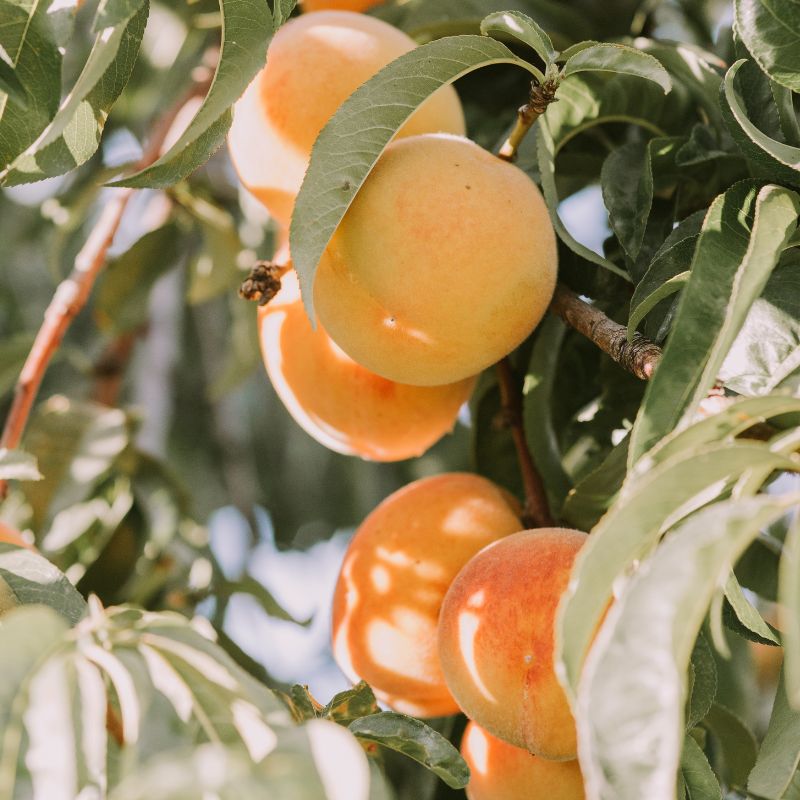

Canadian Harmony Standard Peach
Fresh Eating, Canning, Freezing, Cooking | Mid to Late August Harvest | Hardy to Zone 5 | Mature Ht 15-20 ft | No Staking Required | Self-pollinating
Surely, you’ll be singing Harmony while this peach plays a irresistible melody on your tongue! Canadian Harmony bears large, round peaches with a yellow skin base nearly covered with red blush. The juicy sweet firm yellow flesh is freestone and slow to brown, making any culinary use and processing tons simpler. Some resistance to Bacterial Spot. Fruition’s Canadian Harmony Standard Peach trees are 2-year old, non-organic, bare-root nursery stock.
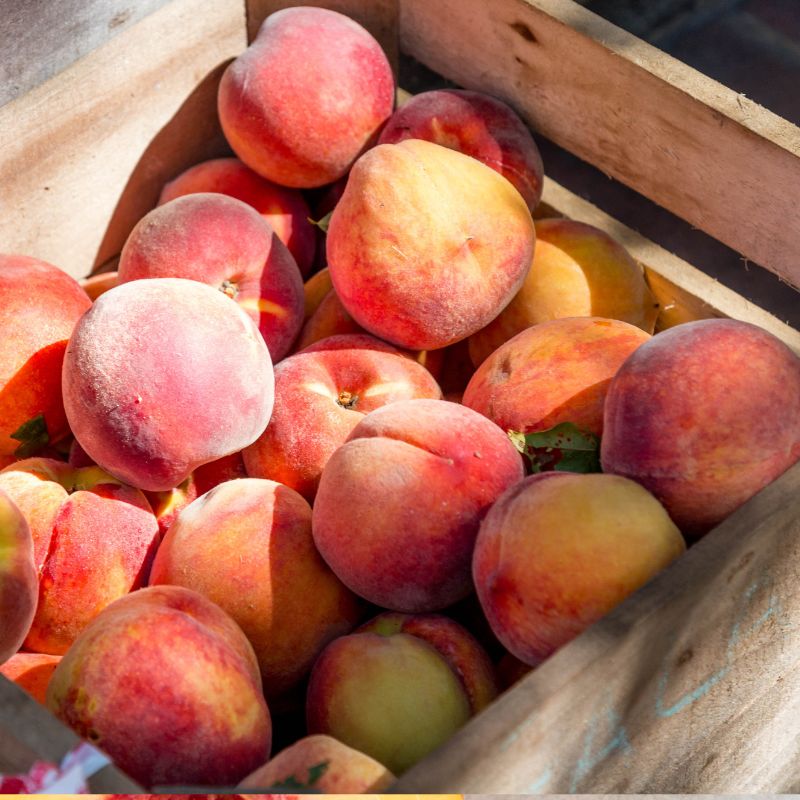

PF 24C Standard Peach Tree
Fresh Eating, Canning, Freezing, Cooking | Late Aug to Early Sept Harvest | Hardy to Zone 4 | Mature Ht 15-20 ft | No Staking Required | Self-pollinating
This new, very cold hardy peach variety is changing the minds of many a cold pocket grower. In the 1990’s, fruit breeder Paul Friday (hence the PF) discovered one seedling still loaded with peaches after all others were left bare by extremely cold Winter temps that damaged their buds. Fast forward to PF 24C! It’s yellow skin is nearly completely covered in red blush, with sweet juicy freestone yellow flesh. 2-year old, non-organic, bare-root nursery stock
Pear Trees
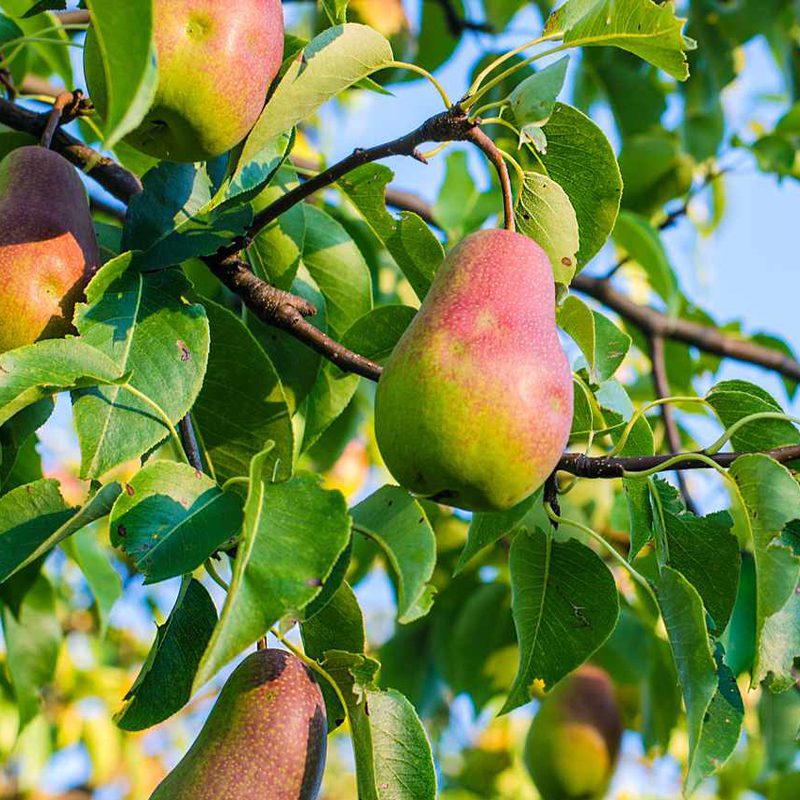

Harrow Sweet™ Semi-Dwarf European Pear Tree
Hardy to Zone 4 | Mature Ht 12-16 ft | No Staking Required | Needs another European Pear variety nearby | Pyrus communis
Ohhhh so sweet, this is our friend David’s favorite pear: “They’re just so buttery and the flavor can’t be beat!” Developed in the 1960s at the Agricultural research station in Harrow, Ontario, this pear blushes red when ripening a few weeks after Bartlett. Excellent Fireblight disease resistance. Our Harrow Sweet Pear trees are 2-year old, non-organic, bare-root nursery stock.
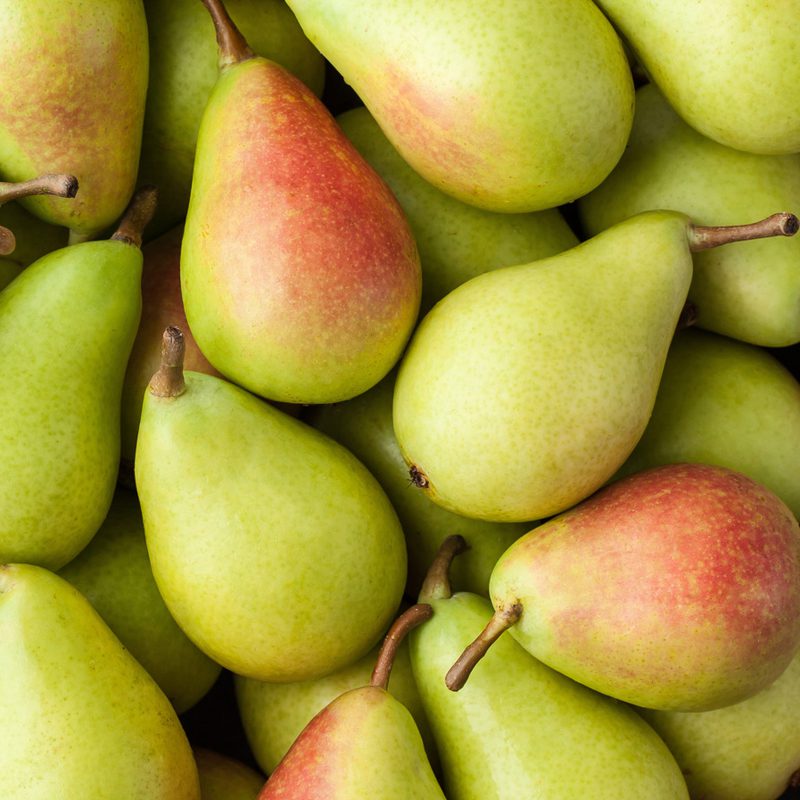

Harrow Delight Semi-Dwarf European Pear Tree
Hardy to Zone 4 | Mature Ht 12-16 ft | No Staking Required | Needs another European Pear variety nearby | Pyrus communis
A small and early pear, best picked with green skin just as a red blush begins, and ripened off the tree. With its complex intense flavor and melting texture, Harrow Delight proves the best things come in small packages. Coldy hardy to zone 4 and very resistant to Fireblight disease. Our Harrow Delight Pear trees are 2-year old, non-organic, bare-root nursery stock.
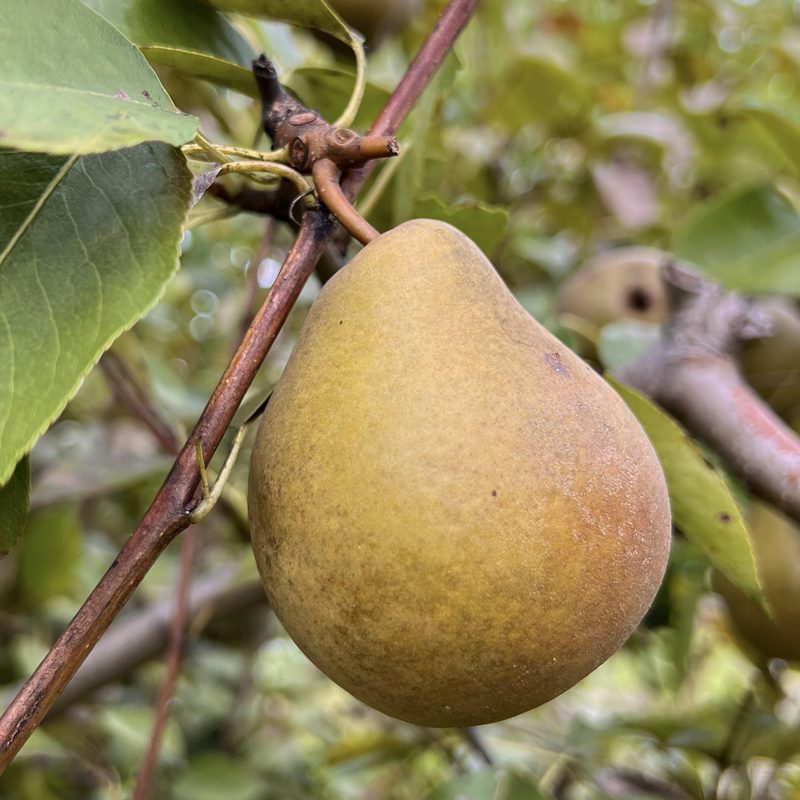

Seckel Heirloom Semi-Dwarf European Pear Tree
Hardy to Zone 4 | Mature Ht 12-18 ft | Ripens Early to Mid Sept | No Staking Required | Needs another European Pear variety nearby
Also called Sugar or Honey Pears, Seckle pears are scrumptious and one of the easiest pears to grow thanks to their impressive spectrum of disease resistance. Seckel pears are small, tucking right into your palm before they melt in your mouth with a lusciously sweet ‘spice’ hinting of nutmeg and clove. Seckel Heirloom Pear trees are 2-year old, non-organic, bare-root nursery stock, resistant to Fireblight, Collar Rot, Wooly Pear Aphid & Pear Decline.
Plum Trees
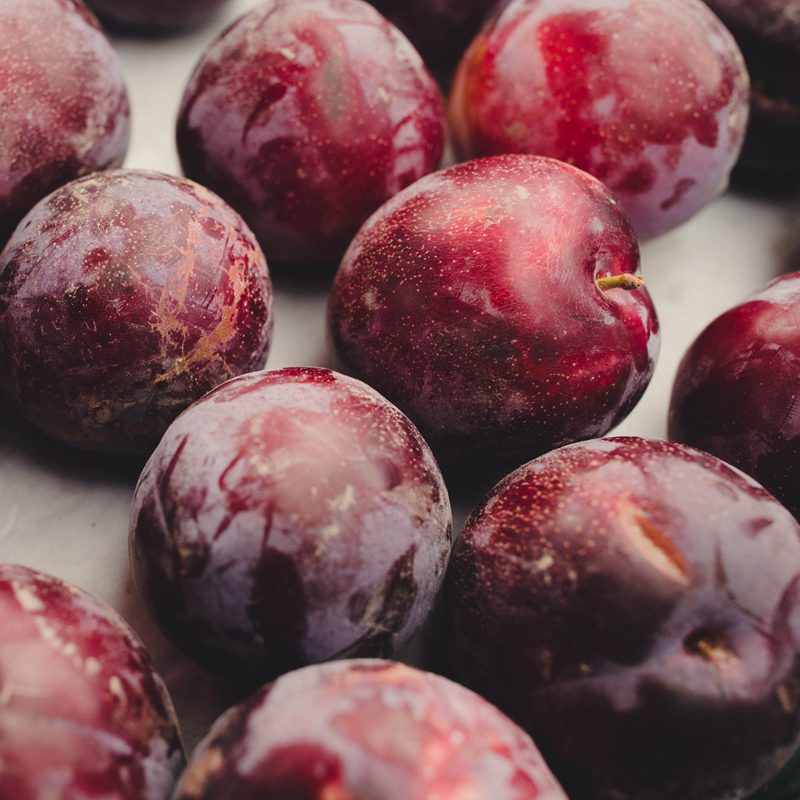

Black Ice® Standard Hybrid Plum Tree
Hardy to Zone 3 | Mature Ht 15-20 ft | No Staking Required | Self-pollinating | Prunus salicina hybrid
Sweet, juicy and I am delirious just remembering eating a Black Ice….Summer cannot come soon enough! Black Ice is actually a Japanese Plum crossed with native Western Sandcherry, released in 2006 from Brian Smith of University of Wisconsin River Falls. The Japanese parent brings the lush dark purple red skin and red-yellow flesh, and the Western Sandcherry lends Black Ice its incredible zone 3 cold hardiness. Black Ice Hybrid Plum trees are 2-year old, non-organic, bare-root nursery stock.
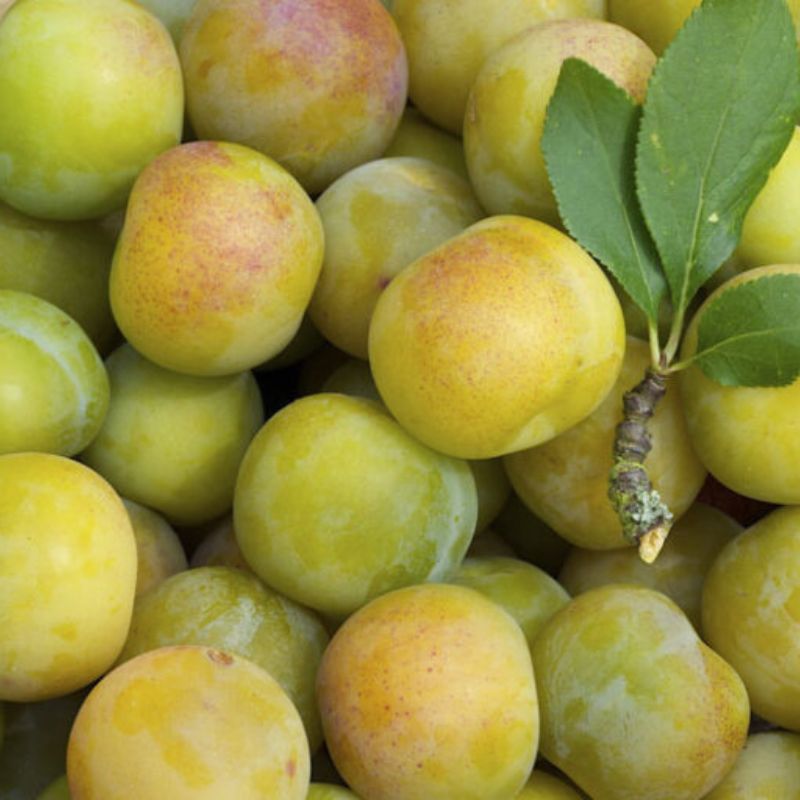

Green Gage Heirloom Standard Plum Tree
Fresh Eating, Cooking, Canning, Drying | Freestone | Early Aug to early Sept Harvest | Hardy to Zone 5 | Mature Ht 10-12 ft | No Staking Required | Self-pollinating
Hailed ‘the truffle of plums,’ the juicy sweetness of Green Gage is exquisitely nuanced beyond Brix. A sweet apple often measures 15 Brix and the luscious yellow-green flesh of Green Gage measures 30 to 38! If you’re looking for extraordinary flavor as well as abundance, Green Gage does not disappoint. Fruition’s Green Gage Heirloom Standard Plum trees are 2-year old, non-organic, bare-root nursery stock.
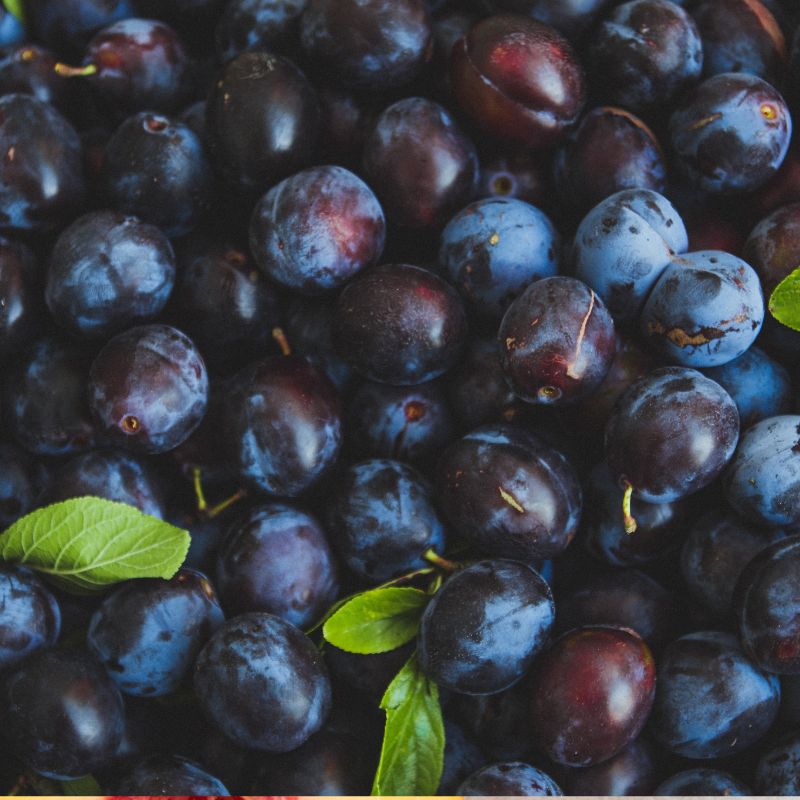

Mount Royal Heirloom Standard Plum Tree
Fresh Eating, Cooking, Canning, Drying | Freestone | Late August Harvest | Hardy to Zone 4 | Mature Ht 10-12 ft | No Staking Required | Self-pollinating
A hardy and prolific European prune plum, Mount Royal is fabulous right off the tree as well as dried, in jam and tucked in baked goods. Their gorgeous white flowers in spring become branches laden with freestone, sumptuous plums with juicy yet firm yellow flesh. Our Mount Royal Heirloom Plum trees are 2-year old, non-organic, bare-root nursery stock.
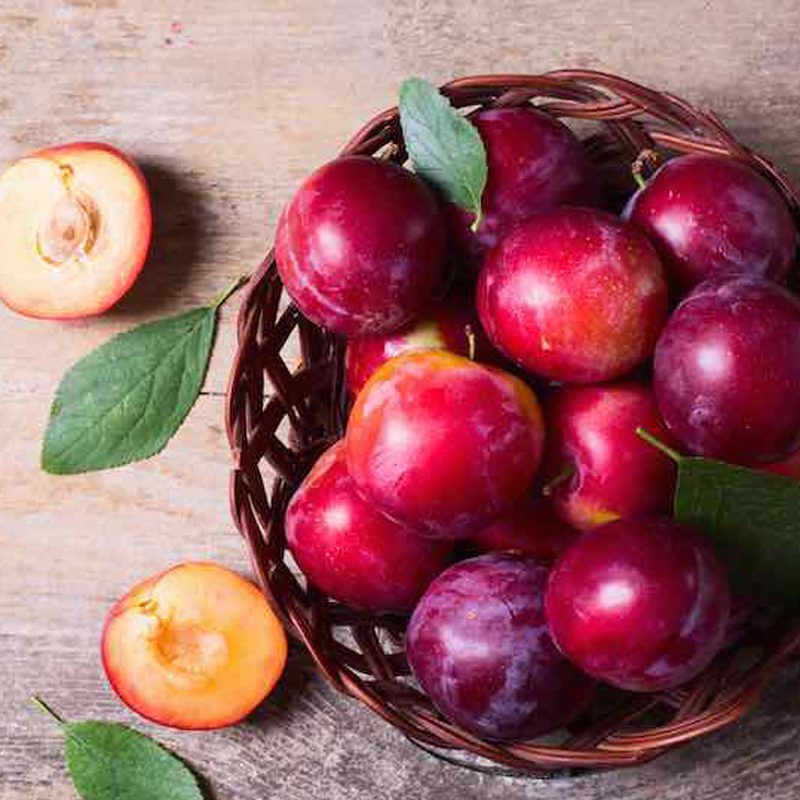

Satsuma Semi-Dwarf Japanese Plum Tree
Hardy to Zone 5 | Mature Ht 10-15 ft | No Staking Required | Needs another Plum variety nearby | Prunus salicina
Delicious Satsuma Japanese Plum has become the most famous fruit variety bred by Luther Burbank. Now a taste classic with its dark red skin, a blush of white “bloom”, and its ripe aromas running straight to our ancient instinctual “eat candy” nerve cluster. Tender, meaty yellow flesh is juicy sweet and simply satisfying. Satsuma Plum trees are 2-year old, non-organic, bare-root nursery stock.
Apple
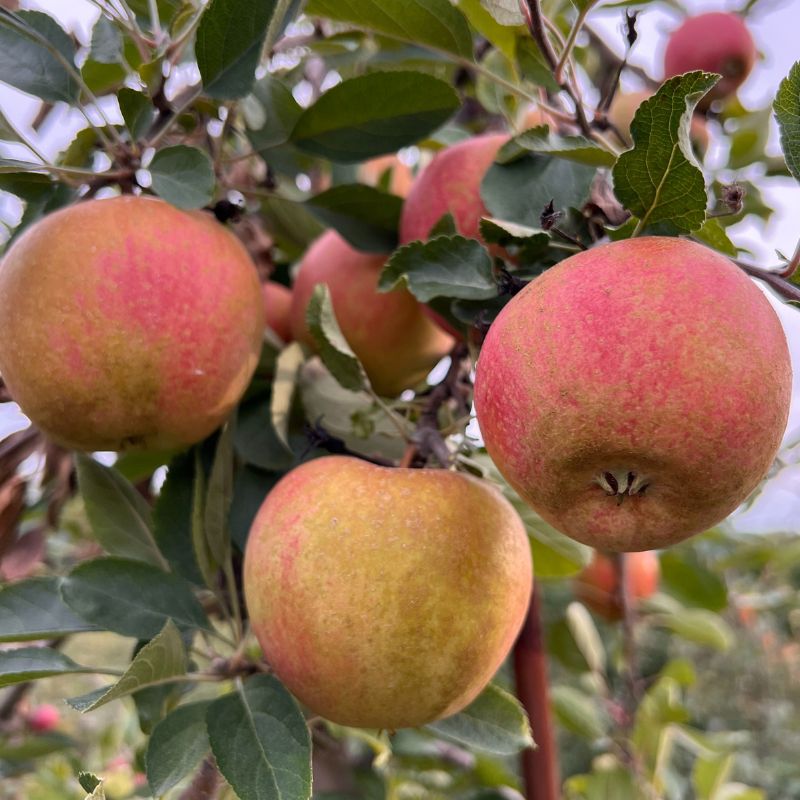

Cox’s Orange Pippin Heirloom Semi-Dwarf Apple Tree
Fresh Eating, Baking, Cider | Mid to Late Season Harvest | Hardy to Zone 4
Cox’s Orange Pippin was a runaway favorite in our taste tests and indeed has captured hearts and tastebuds since its discovery in 1825, setting the standard for great fresh eating aka “dessert” apples. It’s renowned flavor tantalizes with dense yet subtle aromatic notes of spicy citrus, melon & tropical fruit, embedded within nutty sweetness. While not considered disease resistant, it’s consistent eating excellence outweighs any blemish.
May the seeds & trees we plant surround us all with the abundance we dream of!
Sow Seeds & Sing Songs,


with the care of the Fruition Crew
